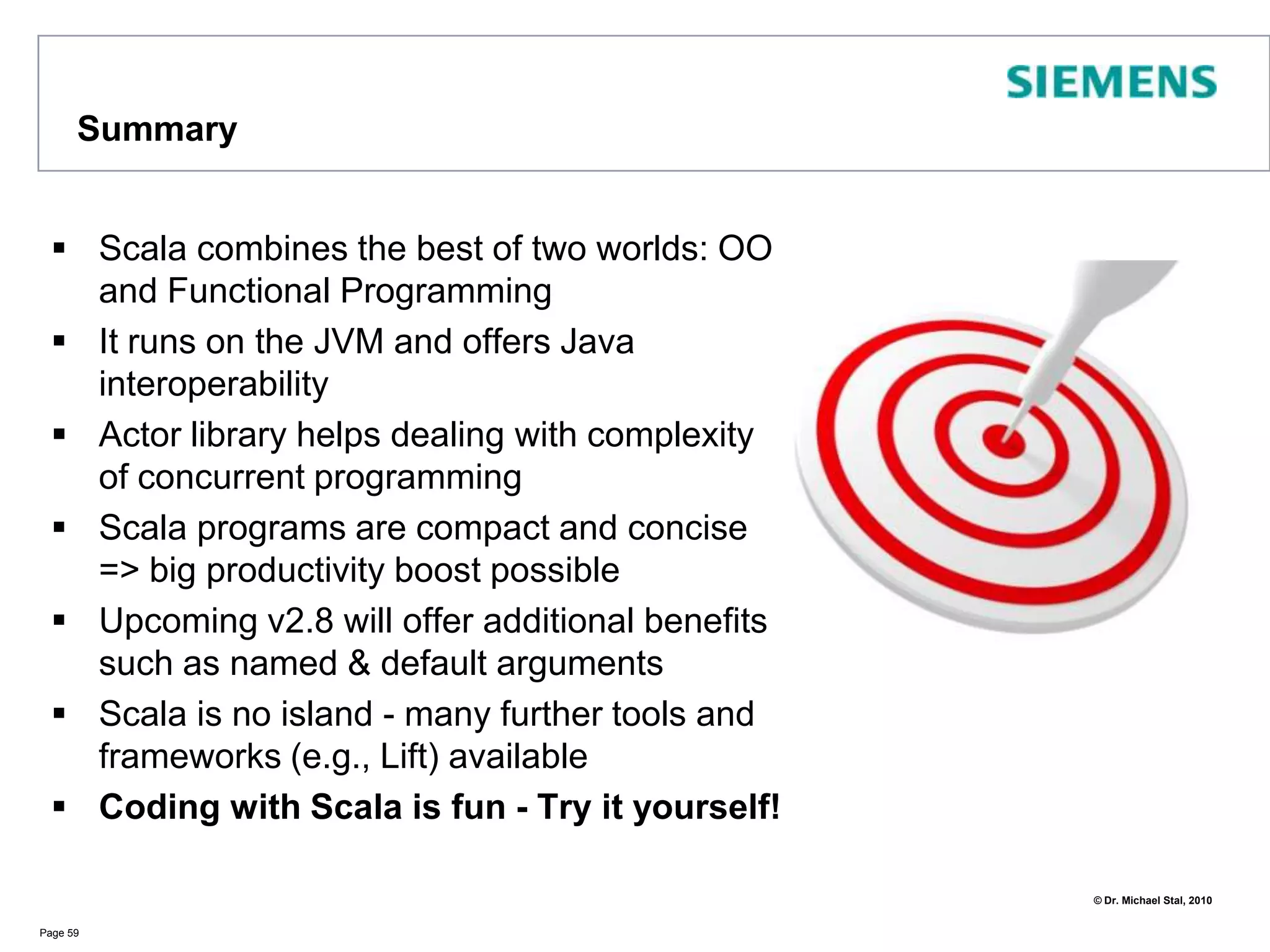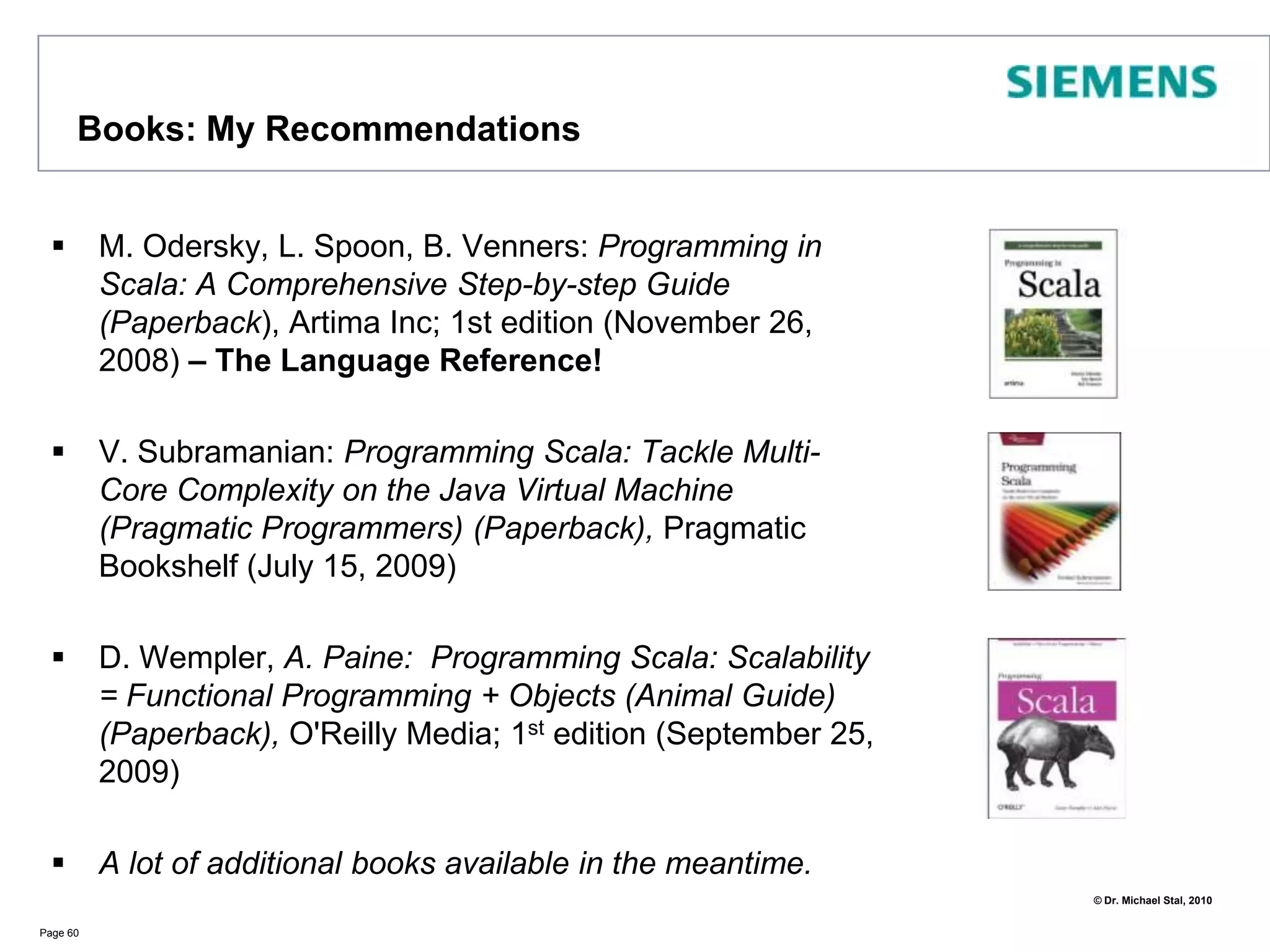The presentation introduces Scala, a statically typed programming language that combines object-oriented and functional programming, developed by Martin Odersky. It covers core concepts such as type inference, immutability, class definitions, inheritance, traits, and various programming constructs like loops and exception handling. Examples of Scala code highlight its conciseness and powerful features, encouraging pragmatic use over theoretical discussion.

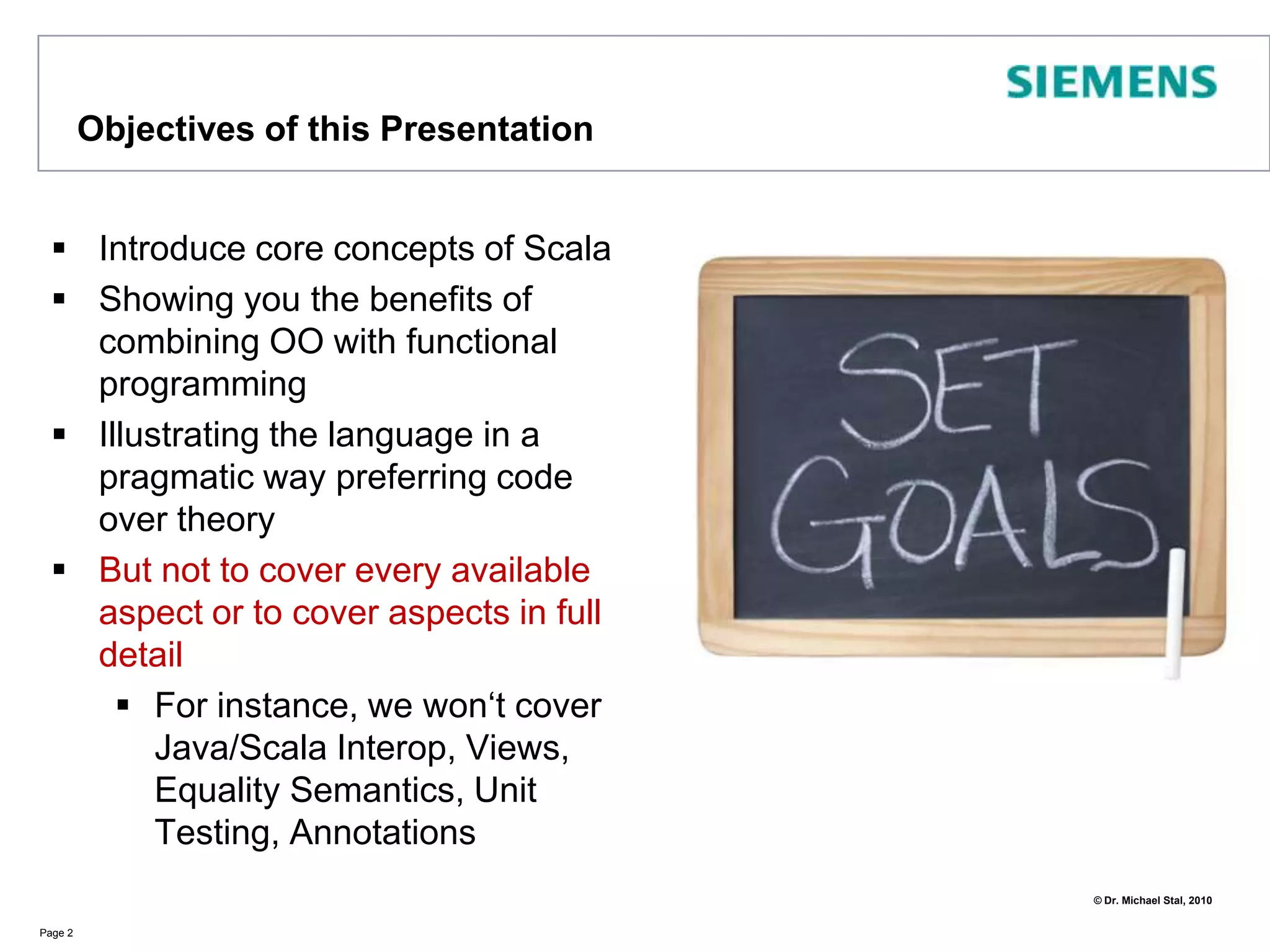
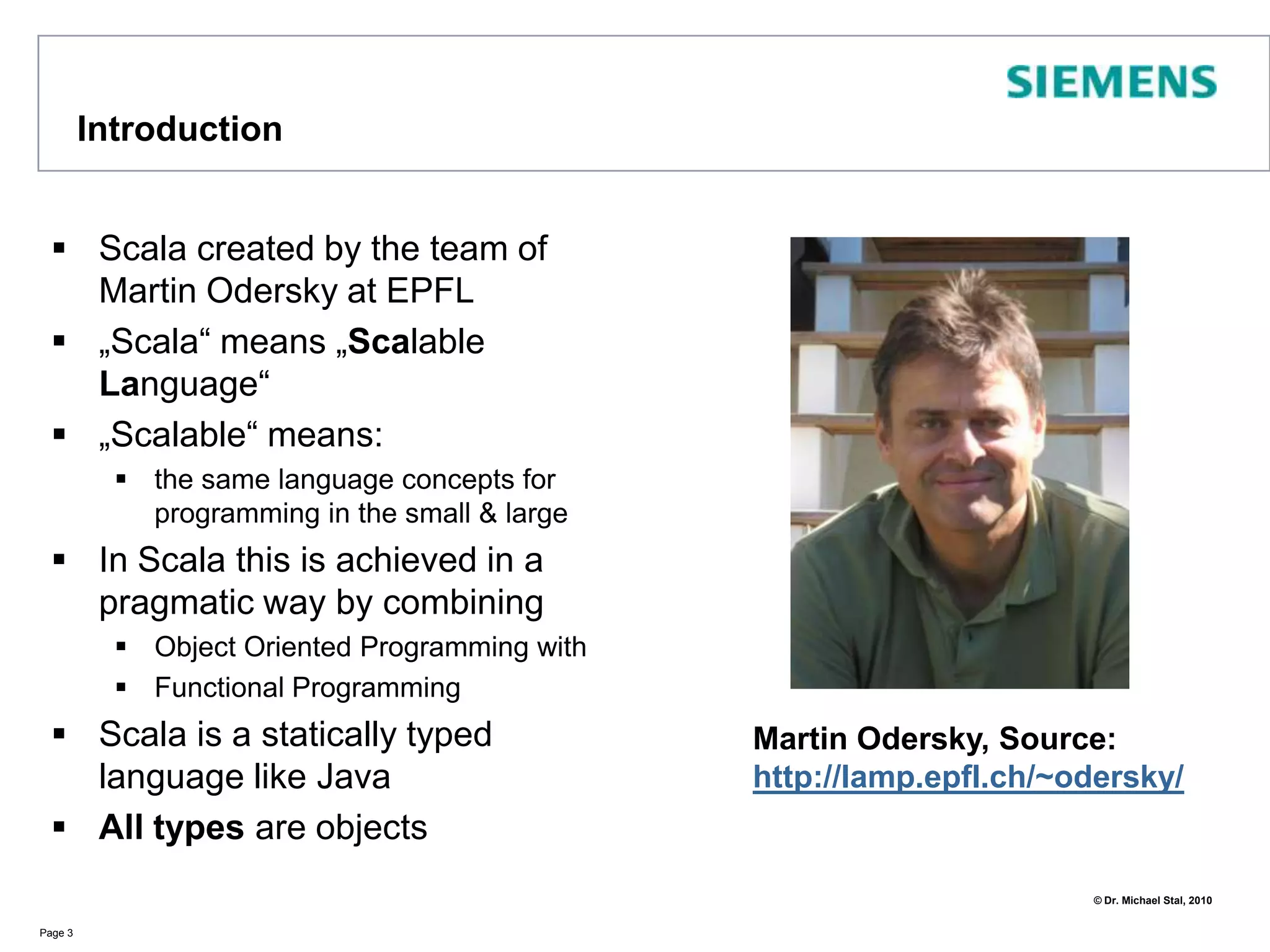
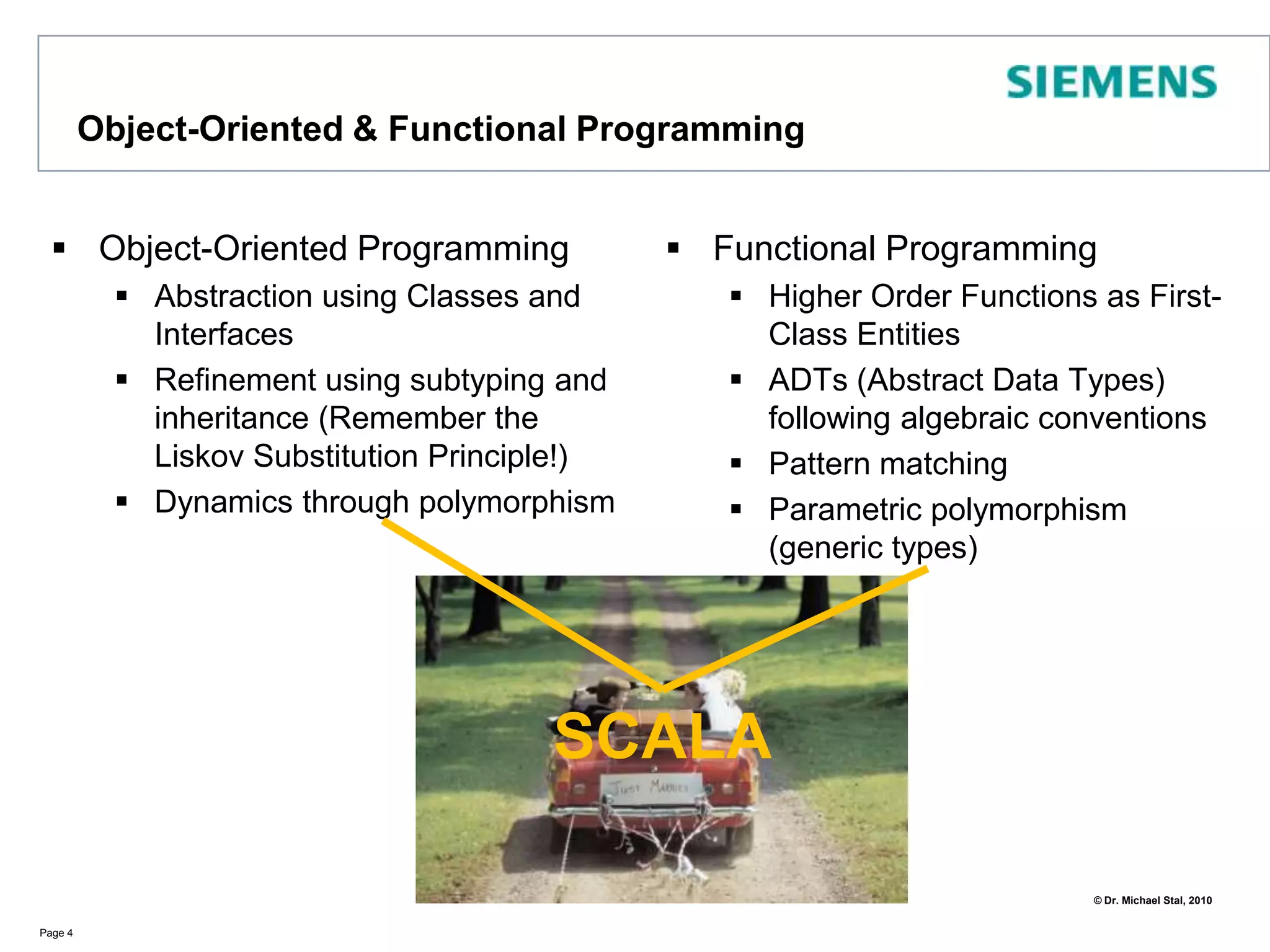
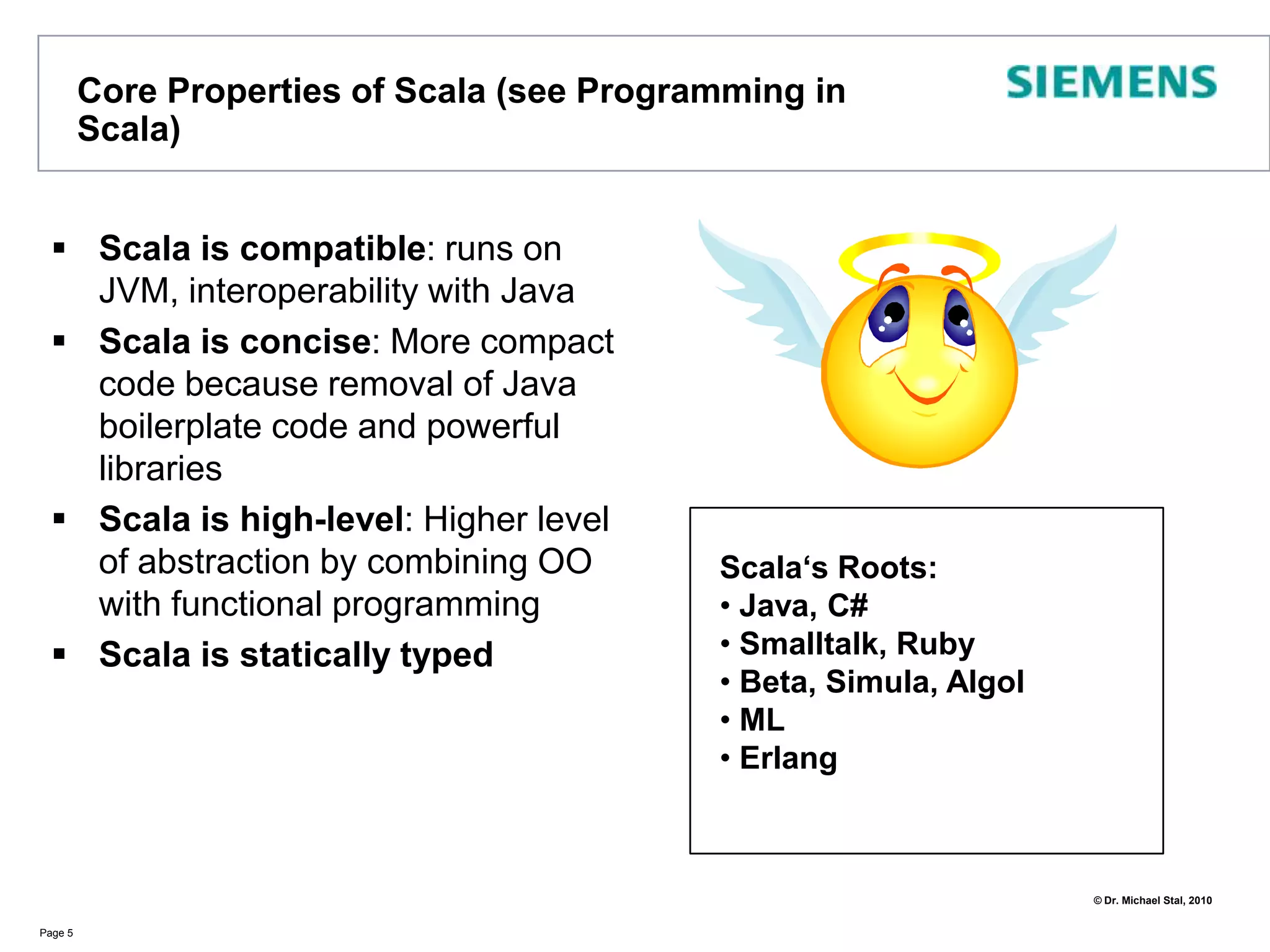
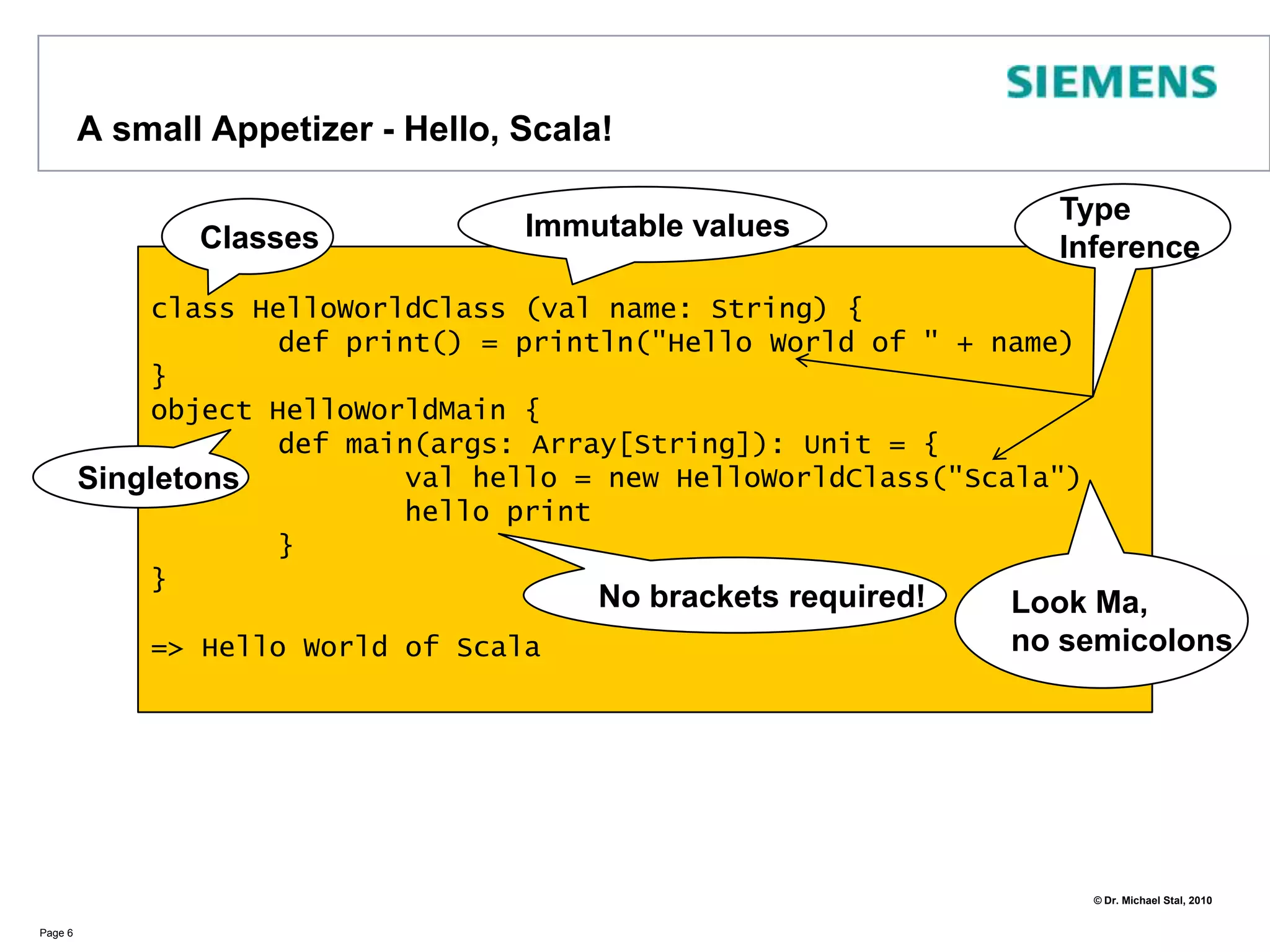
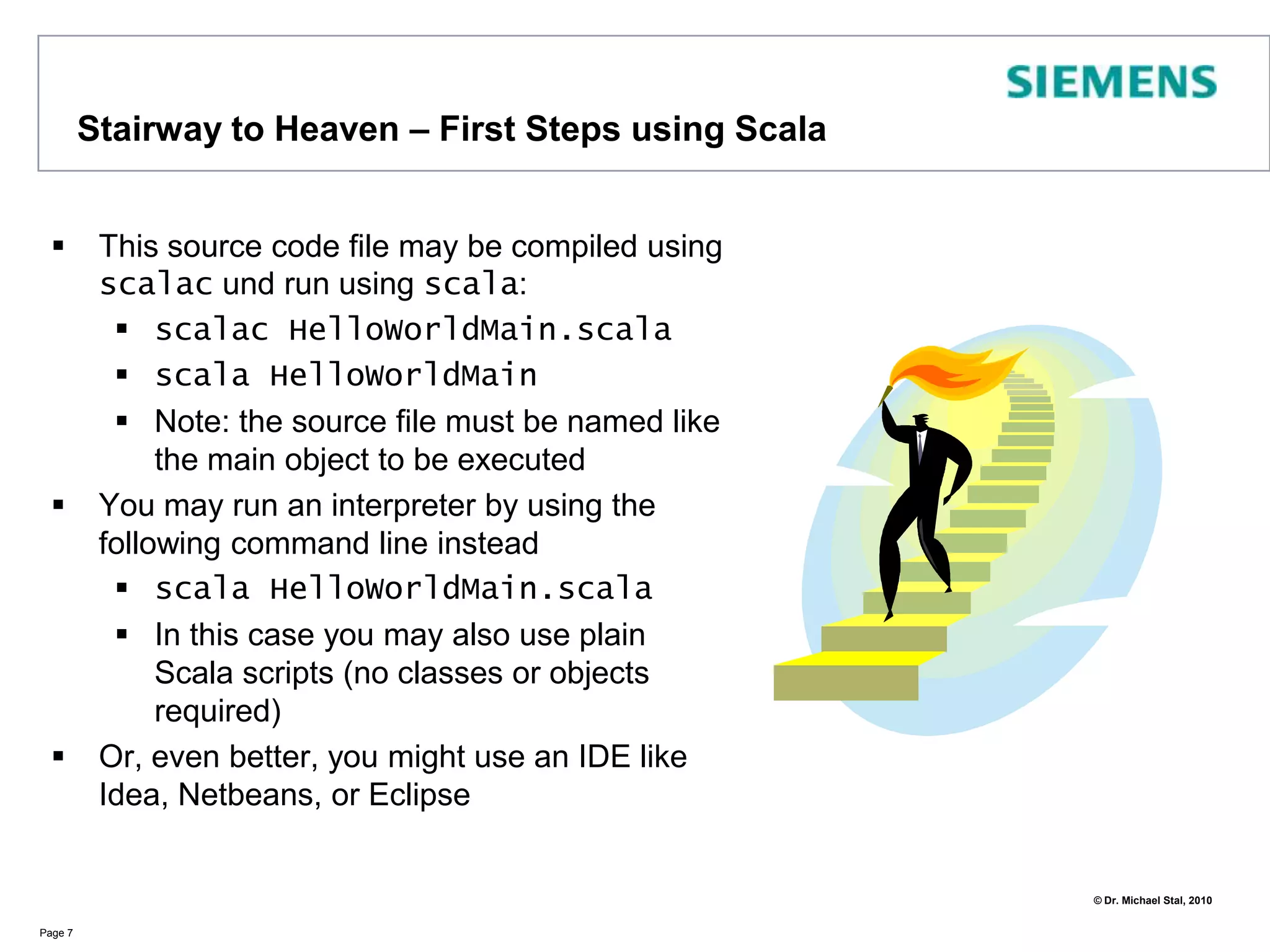
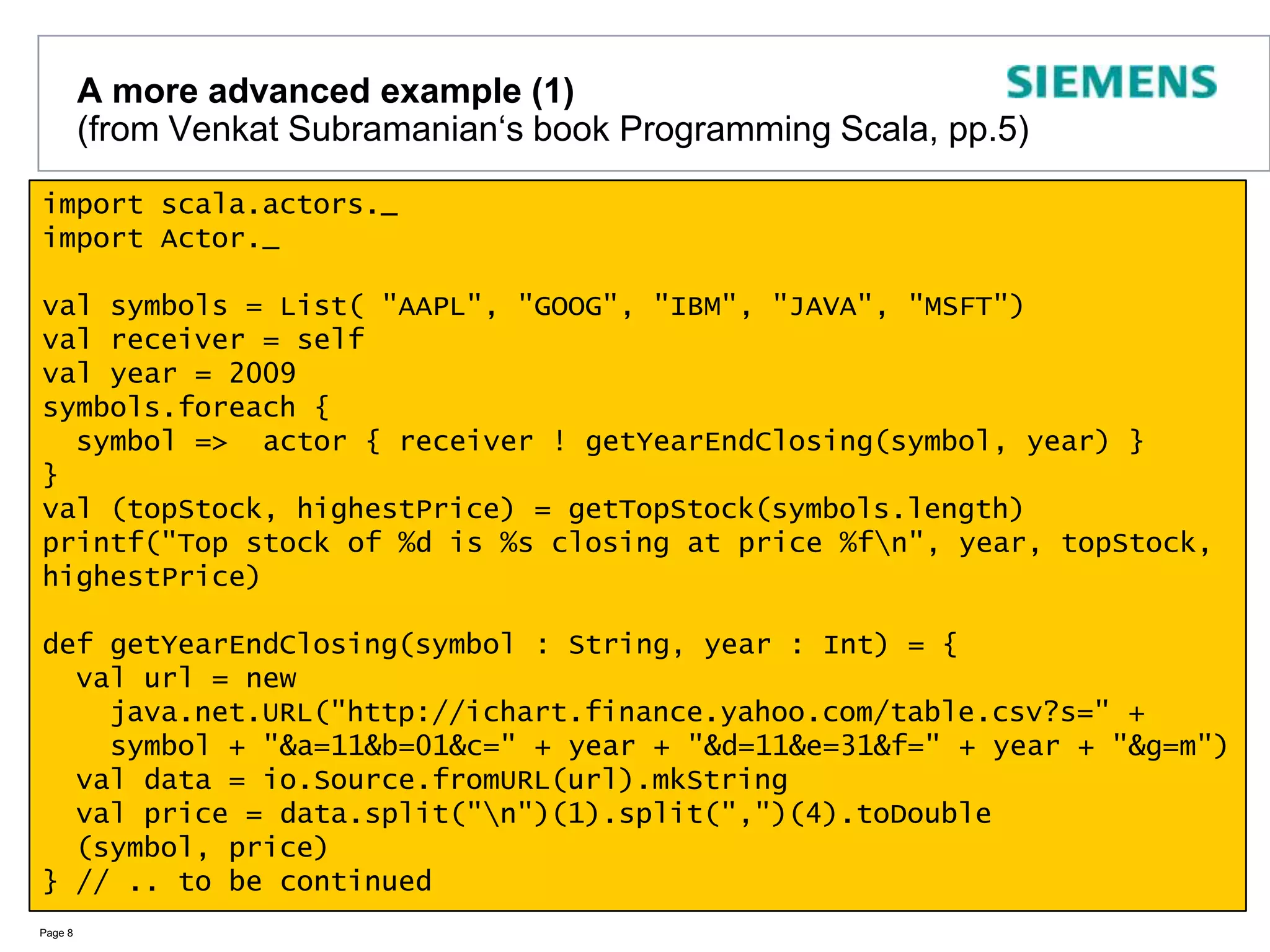
![ErlangA small Appetizer - Hello, Scala!Page 6Type InferenceImmutable valuesClassesclass HelloWorldClass (val name: String) { def print() = println("Hello World of " + name)}object HelloWorldMain { def main(args: Array[String]): Unit = {val hello = new HelloWorldClass("Scala") hello print }}=> Hello World of ScalaSingletonsLook Ma, no semicolonsNo brackets required!](https://image.slidesharecdn.com/oop2010scalapresentationstal-100409090954-phpapp02/75/Oop2010-Scala-Presentation-Stal-9-2048.jpg)
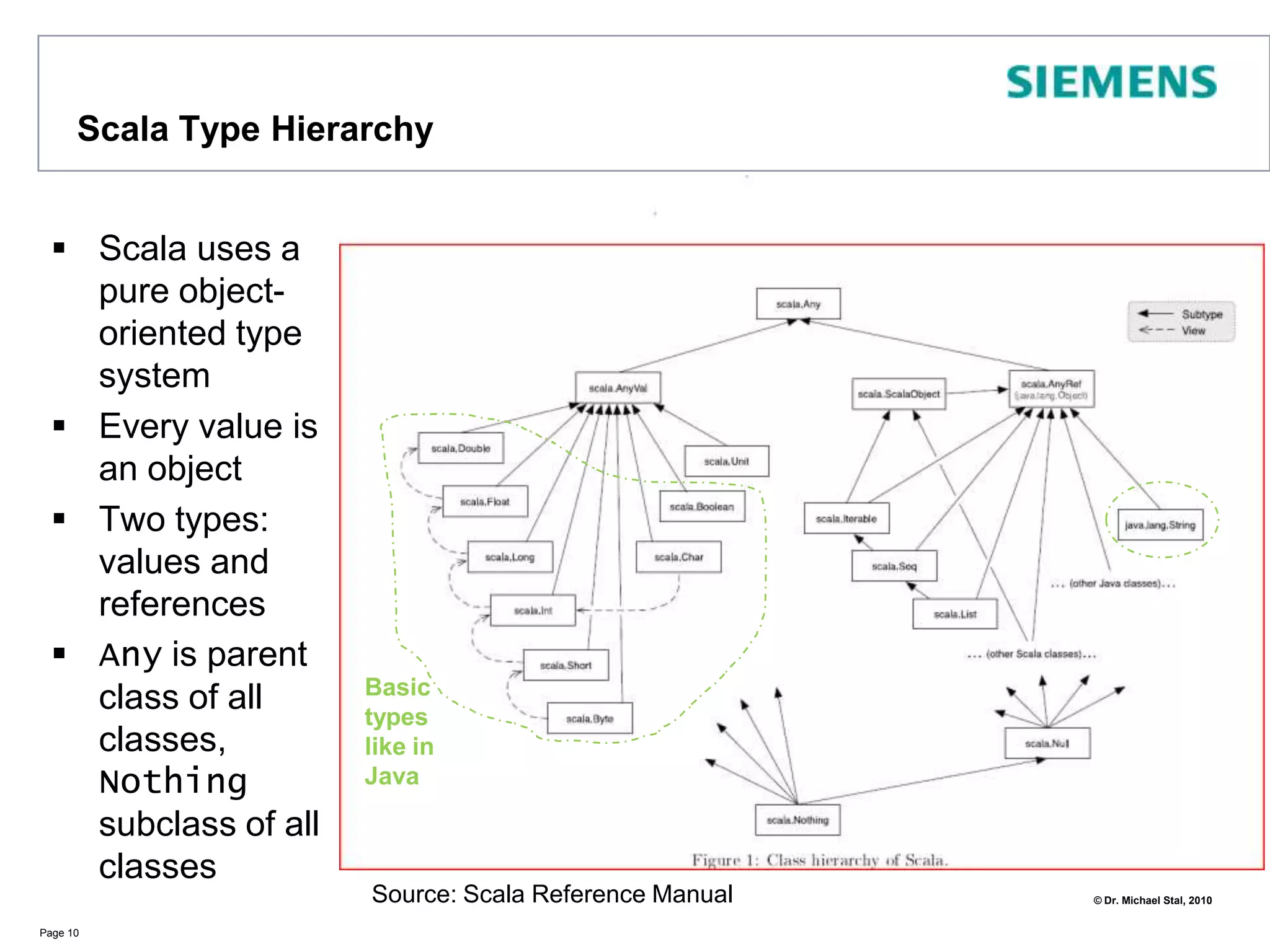
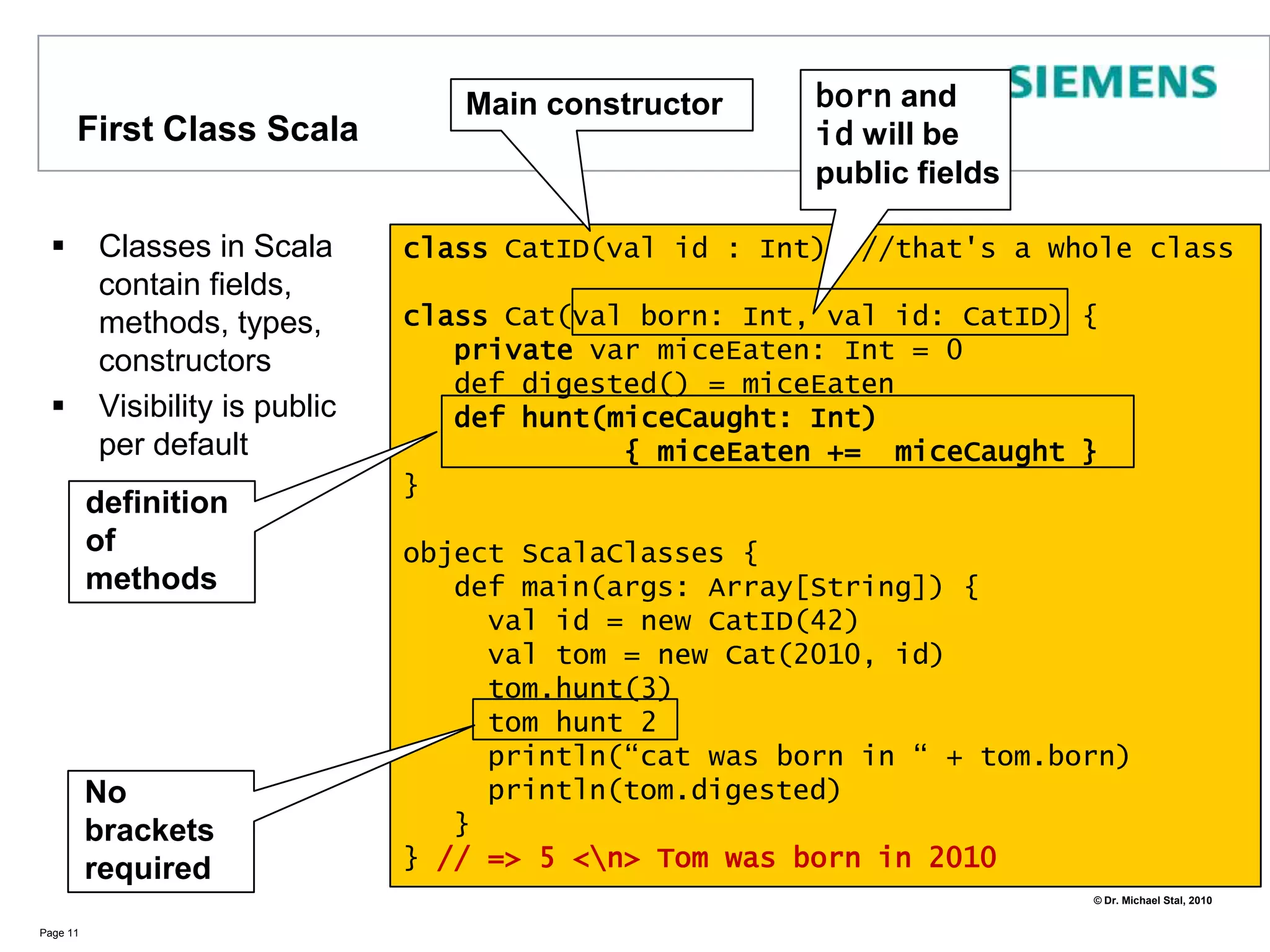
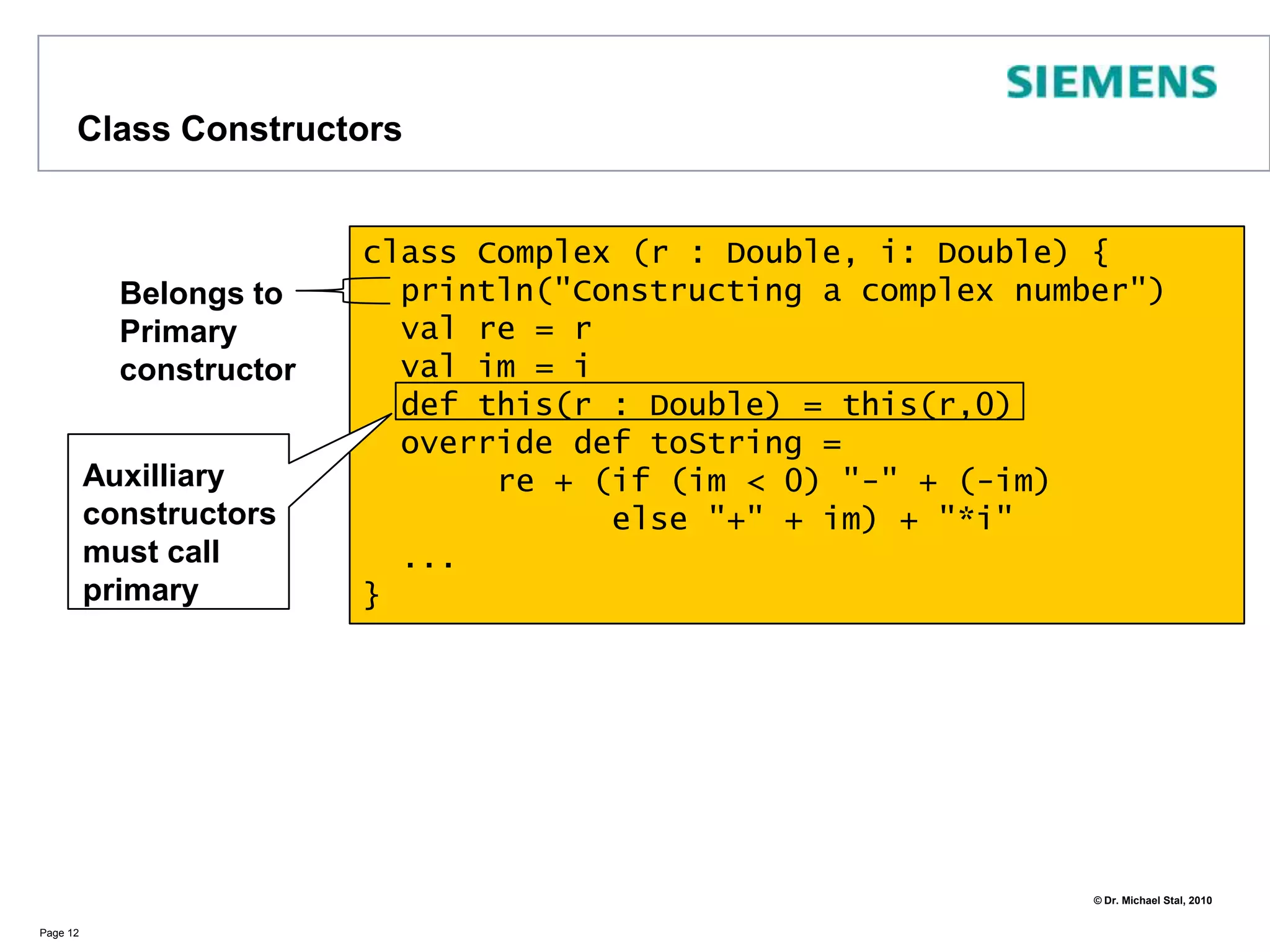
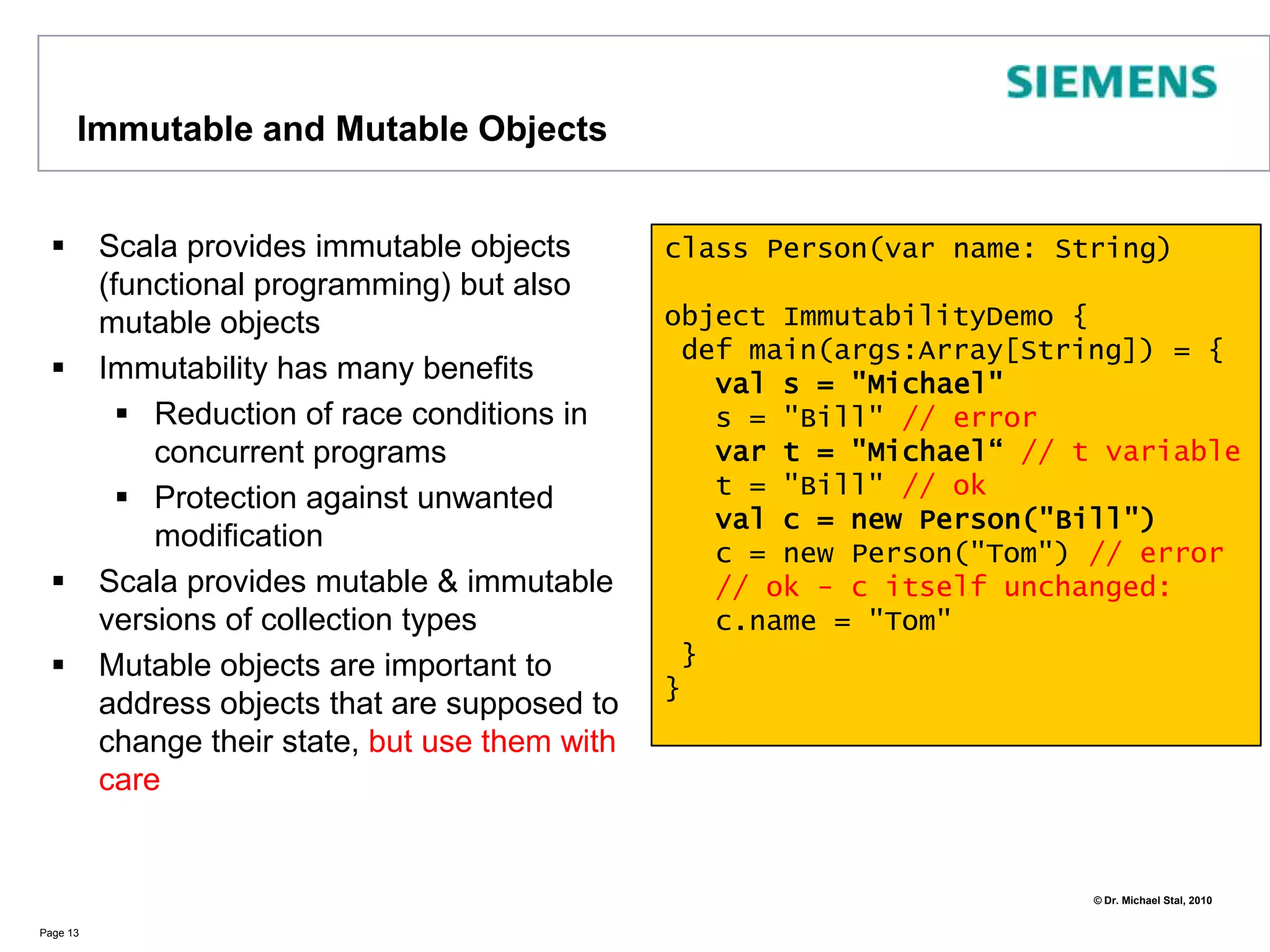
![First Class ScalaPage 11born and id will bepublic fieldsMain constructorClasses in Scala contain fields, methods, types, constructorsVisibility is public per defaultclass CatID(val id : Int) //that's a whole classclass Cat(val born: Int, val id: CatID) {private var miceEaten: Int = 0 def digested() = miceEatendef hunt(miceCaught: Int) { miceEaten += miceCaught }}object ScalaClasses { def main(args: Array[String]) { val id = new CatID(42) val tom = new Cat(2010, id) tom.hunt(3) tom hunt 2 println(“cat was born in “ + tom.born) println(tom.digested) }} // => 5 <\n> Tom was born in 2010 definitionof methodsNo bracketsrequired](https://image.slidesharecdn.com/oop2010scalapresentationstal-100409090954-phpapp02/75/Oop2010-Scala-Presentation-Stal-14-2048.jpg)
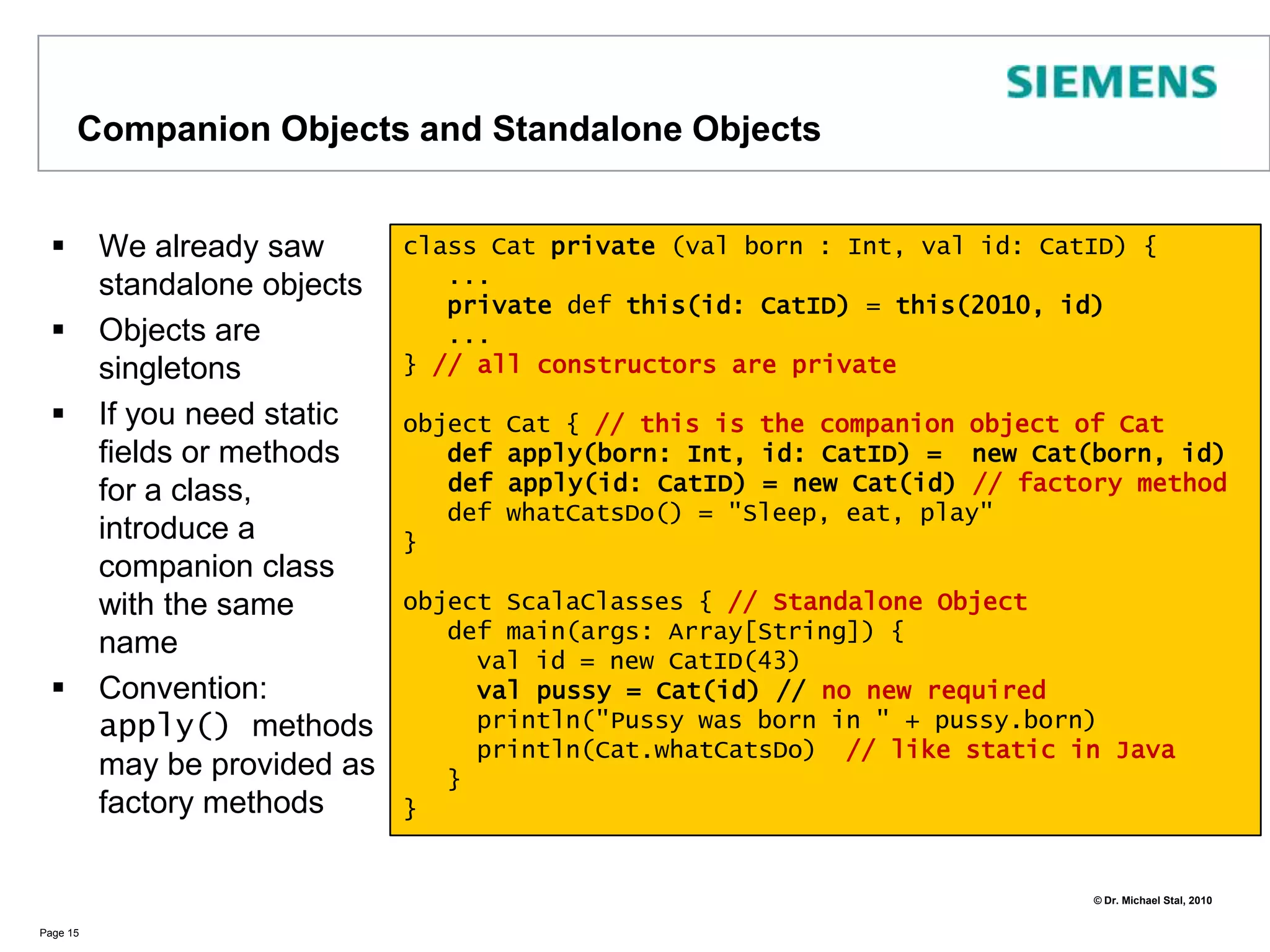
![Immutable and Mutable ObjectsScala provides immutable objects (functional programming) but also mutable objectsImmutability has many benefitsReduction of race conditions in concurrent programsProtection against unwanted modificationScala provides mutable & immutable versions of collection typesMutable objects are important to address objects that are supposed to change their state, but use them with carePage 13class Person(var name: String)object ImmutabilityDemo { def main(args:Array[String]) = {val s = "Michael" s = "Bill" // errorvar t = "Michael“ // t variable t = "Bill" // ok val c = new Person("Bill") c = new Person("Tom") // error// ok - c itself unchanged: c.name = "Tom" }}](https://image.slidesharecdn.com/oop2010scalapresentationstal-100409090954-phpapp02/75/Oop2010-Scala-Presentation-Stal-16-2048.jpg)
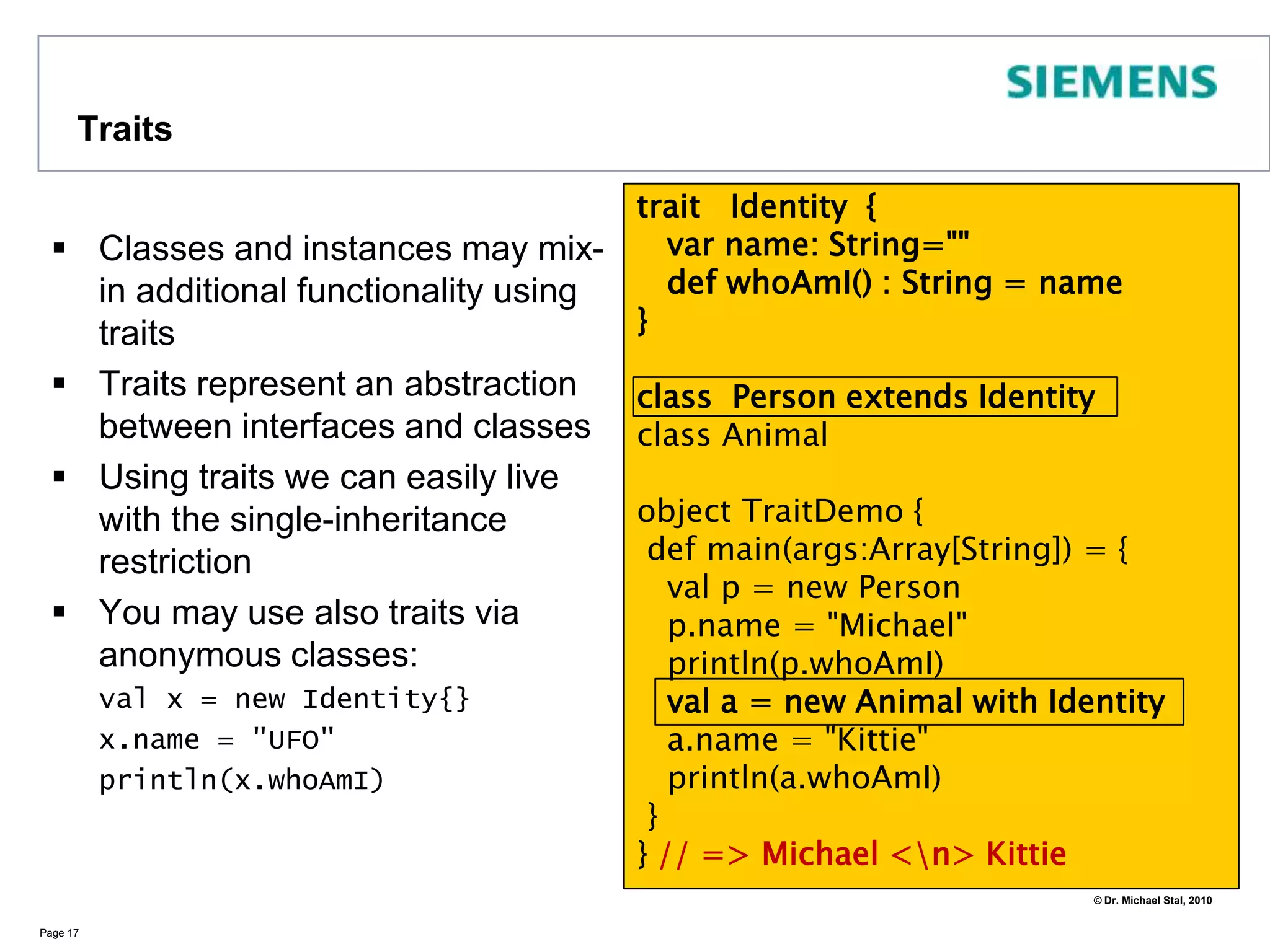
![Companion Objects and Standalone ObjectsWe already saw standalone objectsObjects are singletonsIf you need static fields or methods for a class, introduce a companion class with the same nameConvention: apply() methods may be provided as factory methodsPage 15class Cat private (val born : Int, val id: CatID) { ...private def this(id: CatID) = this(2010, id) ...} // all constructors are privateobject Cat { // this is the companion object of Catdef apply(born: Int, id: CatID) = new Cat(born, id) def apply(id: CatID) = new Cat(id) // factory method def whatCatsDo() = "Sleep, eat, play" }object ScalaClasses { // Standalone Object def main(args: Array[String]) { val id = new CatID(43)val pussy = Cat(id) // no new required println("Pussy was born in " + pussy.born) println(Cat.whatCatsDo) // like static in Java }}](https://image.slidesharecdn.com/oop2010scalapresentationstal-100409090954-phpapp02/75/Oop2010-Scala-Presentation-Stal-18-2048.jpg)
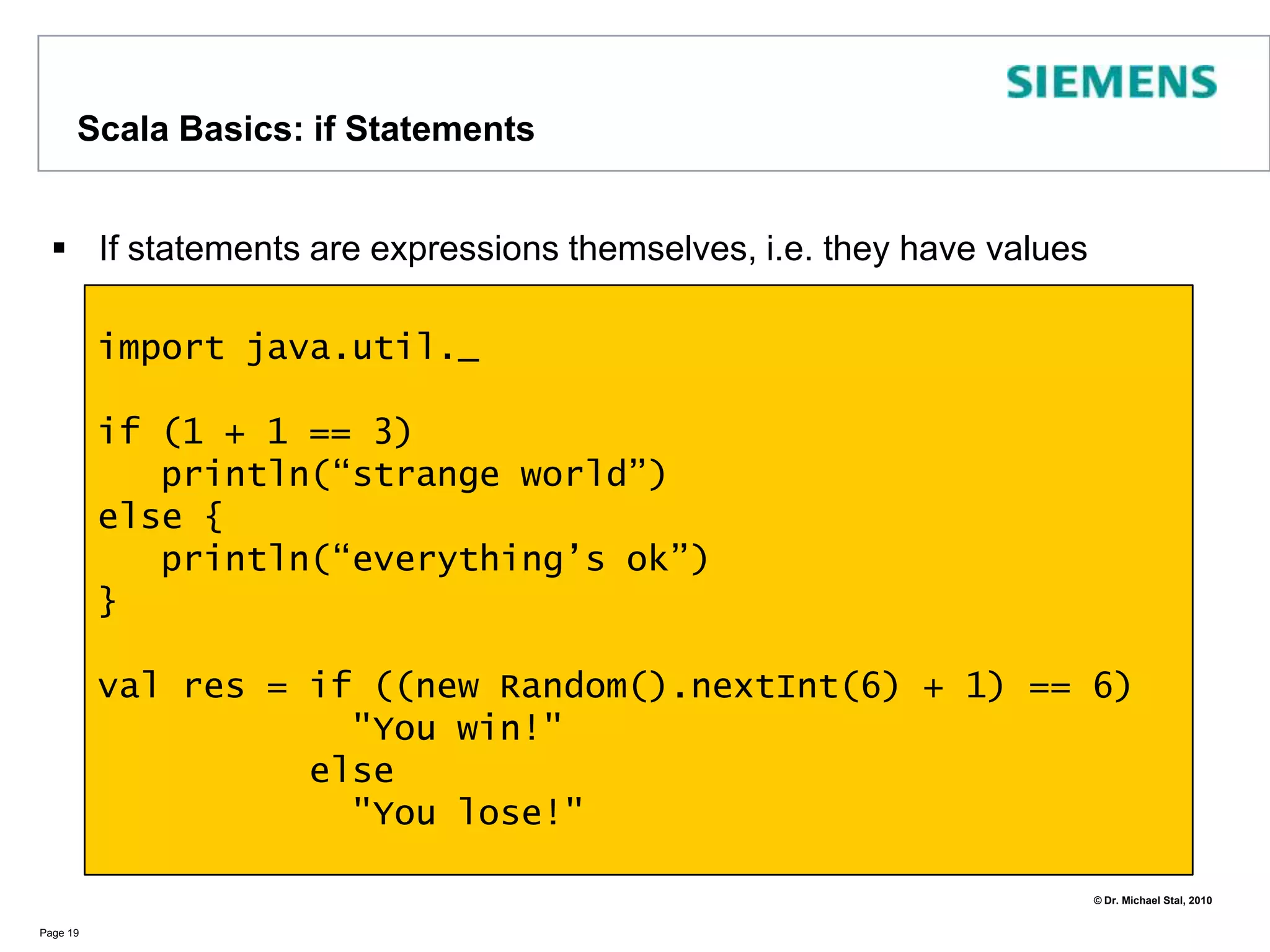
![TraitsClasses and instances may mix-in additional functionality using traitsTraits represent an abstraction between interfaces and classesUsing traits we can easily live with the single-inheritance restrictionYou may use also traits via anonymous classes: val x = new Identity{} x.name = "UFO" println(x.whoAmI)Page 17trait Identity { var name: String="" def whoAmI() : String = name }class Person extends Identity class Animalobject TraitDemo { def main(args:Array[String]) = { val p = new Person p.name = "Michael" println(p.whoAmI)val a = new Animal with Identity a.name = "Kittie" println(a.whoAmI) }} // => Michael <\n> Kittie](https://image.slidesharecdn.com/oop2010scalapresentationstal-100409090954-phpapp02/75/Oop2010-Scala-Presentation-Stal-20-2048.jpg)
![Traits and Virtual Super: Inheritance LinearizationPage 18abstract class Processor { def process() }trait Compressor extends Processor { // trait only applicable to Processor subclassabstract override def process() = { println("I am compressing"); super.process }}trait Encryptor extends Processor { // only applicable to Processor subclassabstract override def process() = { println("I am encrypting"); super.process}}class SampleProcessor extends Processor { // subclass of Processor override def process() = println("I am a Sample Processor")}object traitsample2 { def main(args:Array[String]) = { // mixing in a trait to an object:val proc1 = new SampleProcessor with Compressor with Encryptorproc1.process// Encryptor.process=>Compressor.process } // => SampleProcessor.process}Note: abstract override for a trait method means the actual subclass of Processor will provide a concrete implementation of that method!](https://image.slidesharecdn.com/oop2010scalapresentationstal-100409090954-phpapp02/75/Oop2010-Scala-Presentation-Stal-21-2048.jpg)
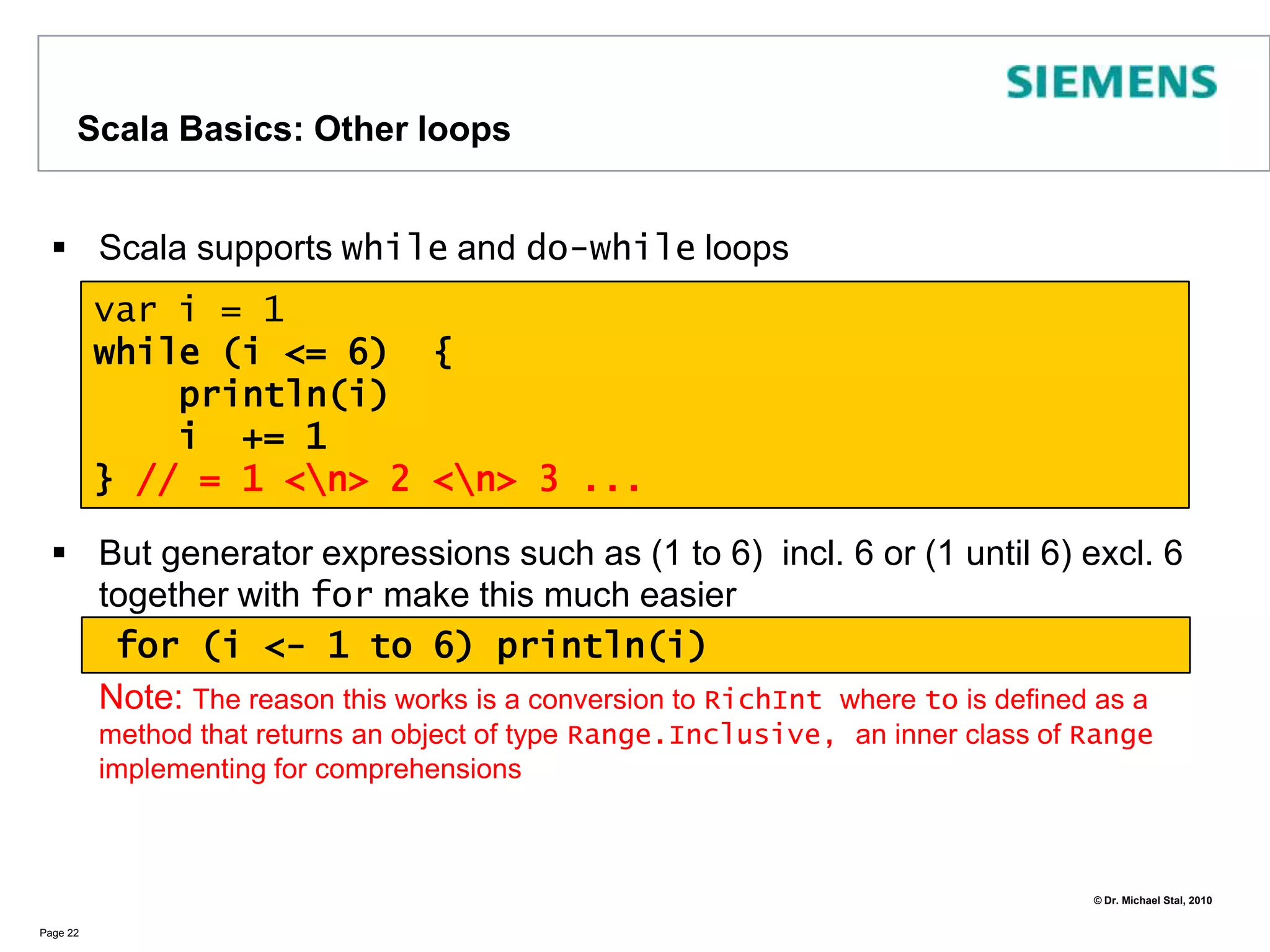
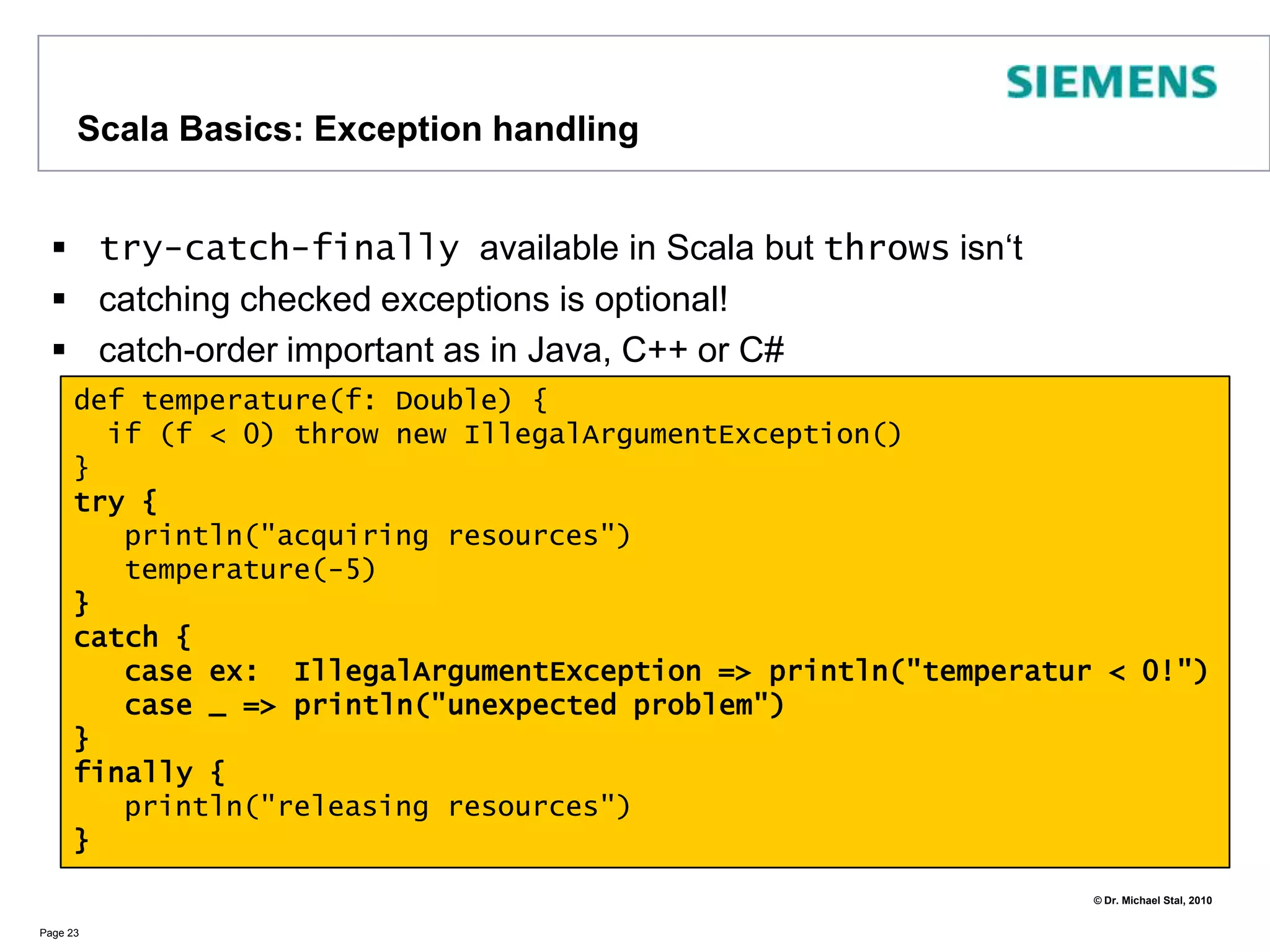
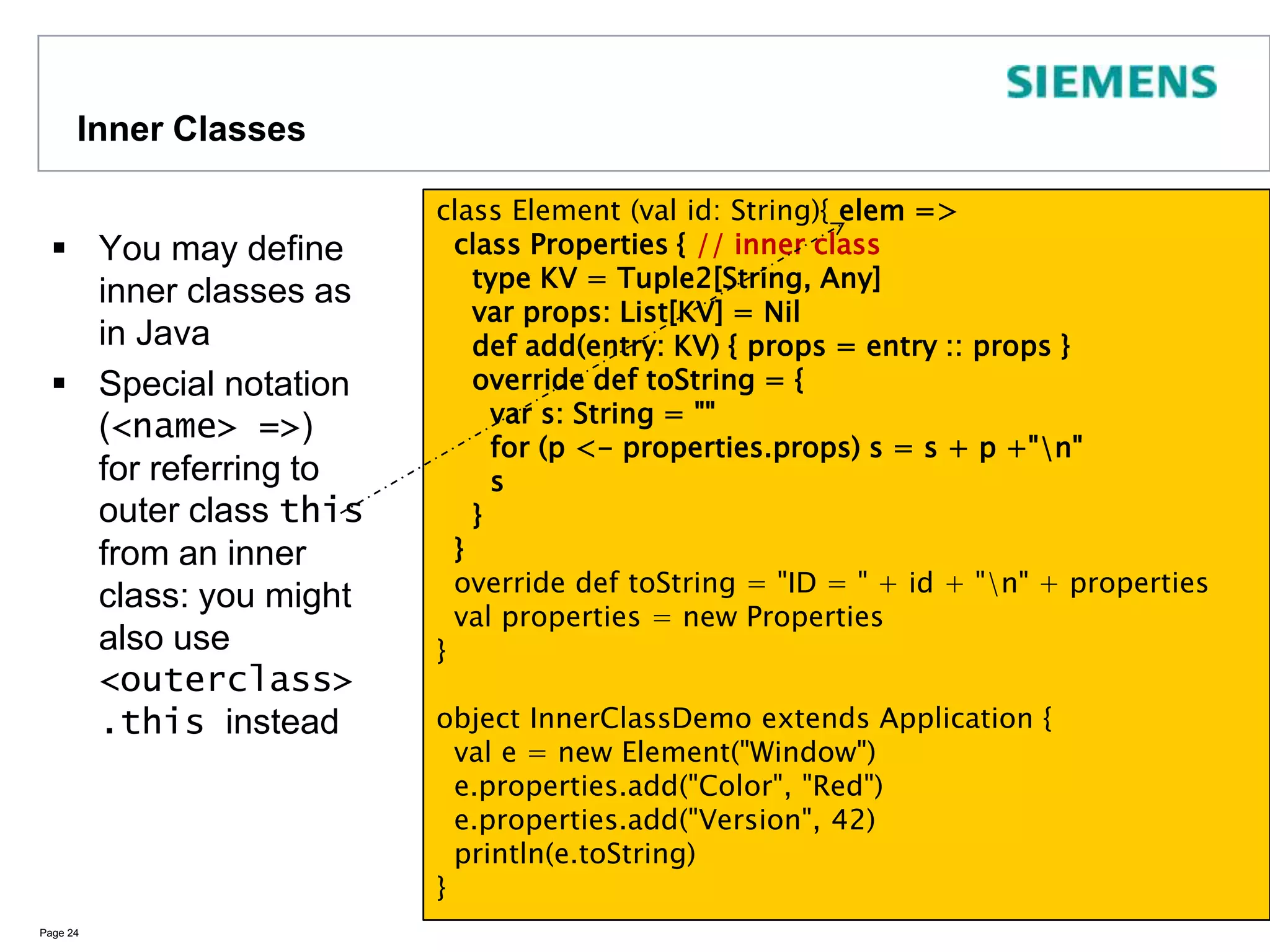
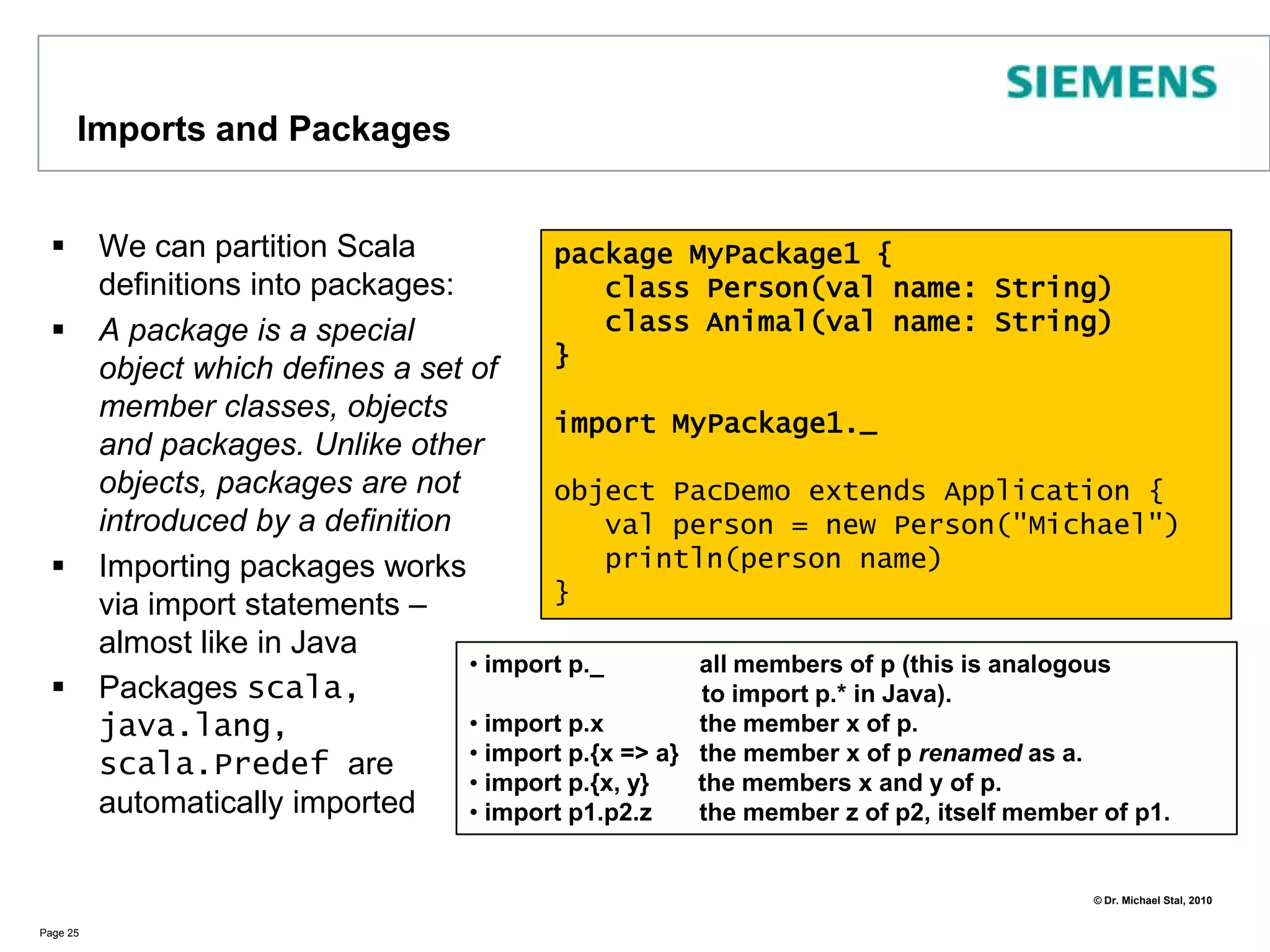
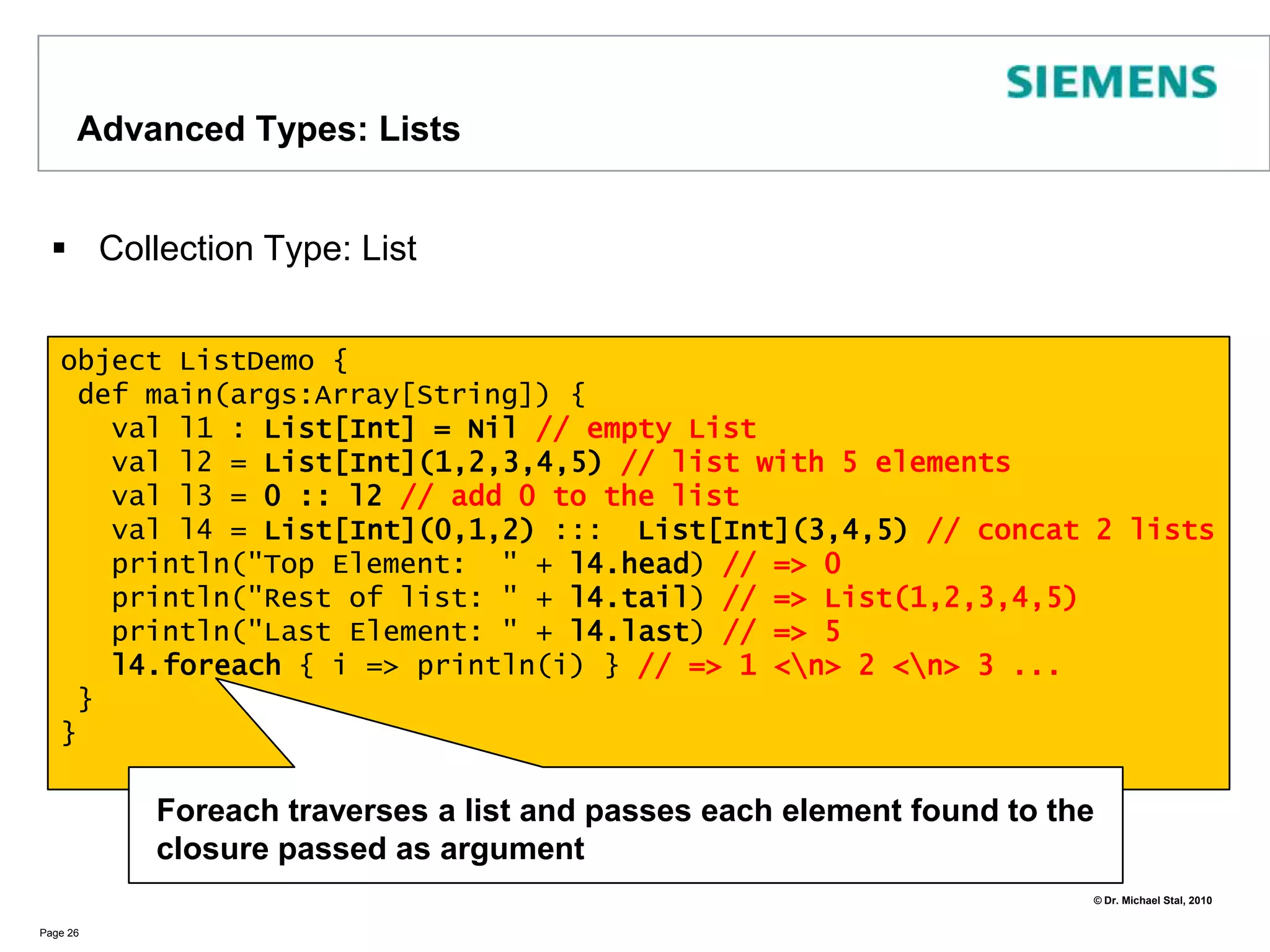
![Inner ClassesYou may define inner classes as in JavaSpecial notation (<name> =>) for referring to outer class this from an inner class: you might also use <outerclass>.this insteadPage 24class Element (val id: String){ elem =>class Properties { // inner classtype KV = Tuple2[String, Any] var props: List[KV] = Nil def add(entry: KV) { props = entry :: props } override def toString = { var s: String = "" for (p <- properties.props) s = s + p +"\n" s }} override def toString = "ID = " + id + "\n" + properties val properties = new Properties }object InnerClassDemo extends Application { val e = new Element("Window") e.properties.add("Color", "Red") e.properties.add("Version", 42) println(e.toString)}](https://image.slidesharecdn.com/oop2010scalapresentationstal-100409090954-phpapp02/75/Oop2010-Scala-Presentation-Stal-27-2048.jpg)
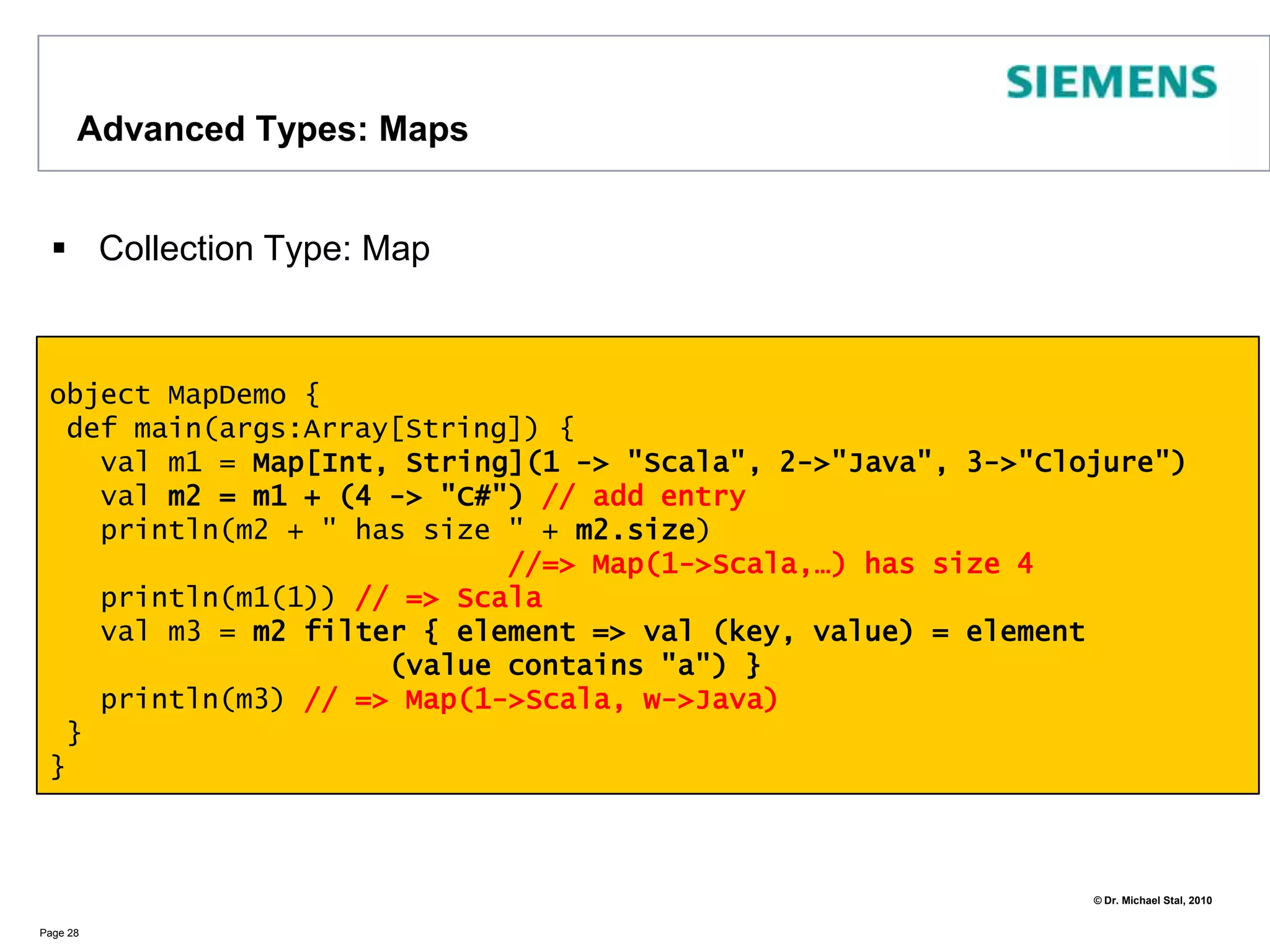
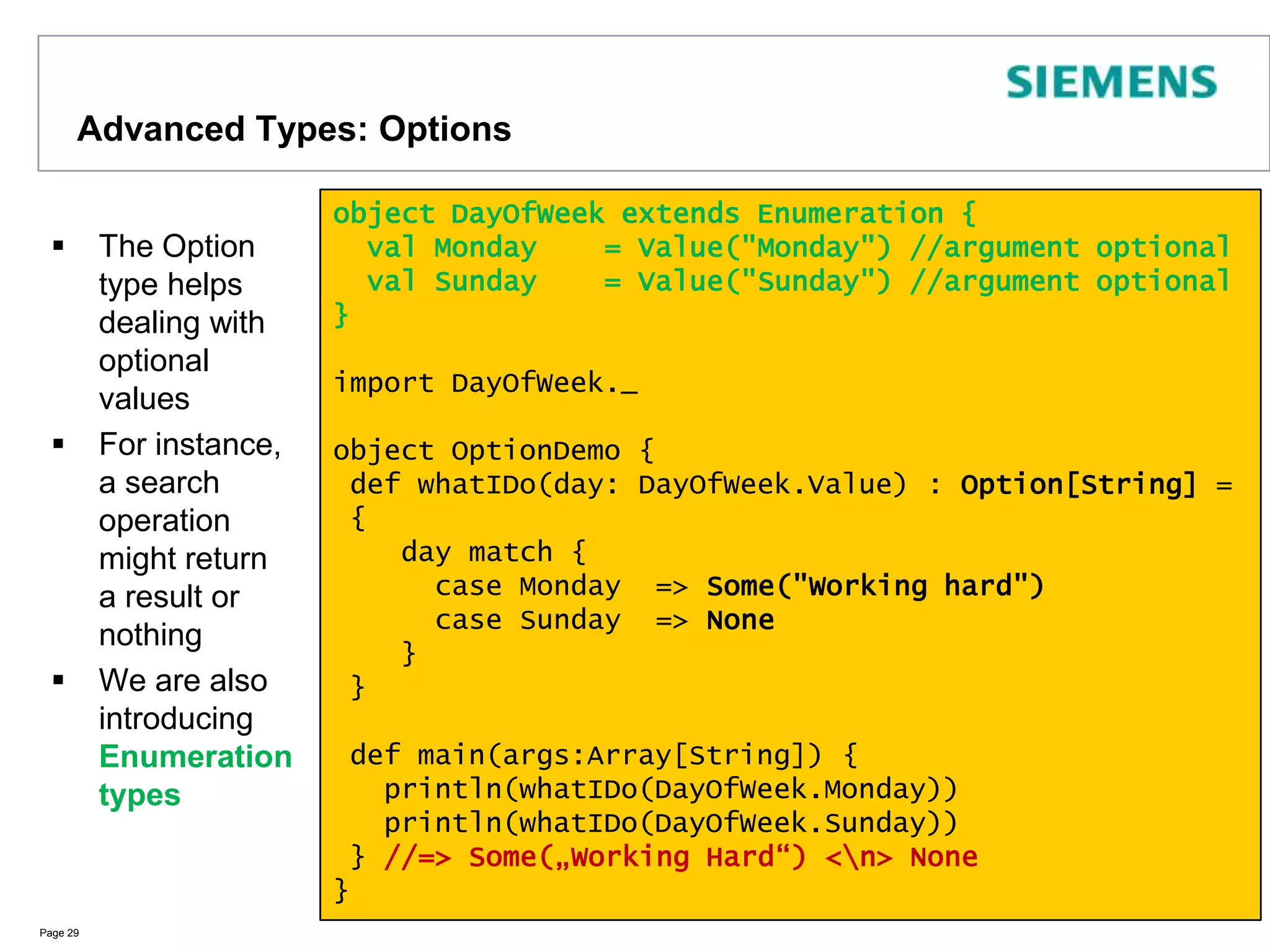
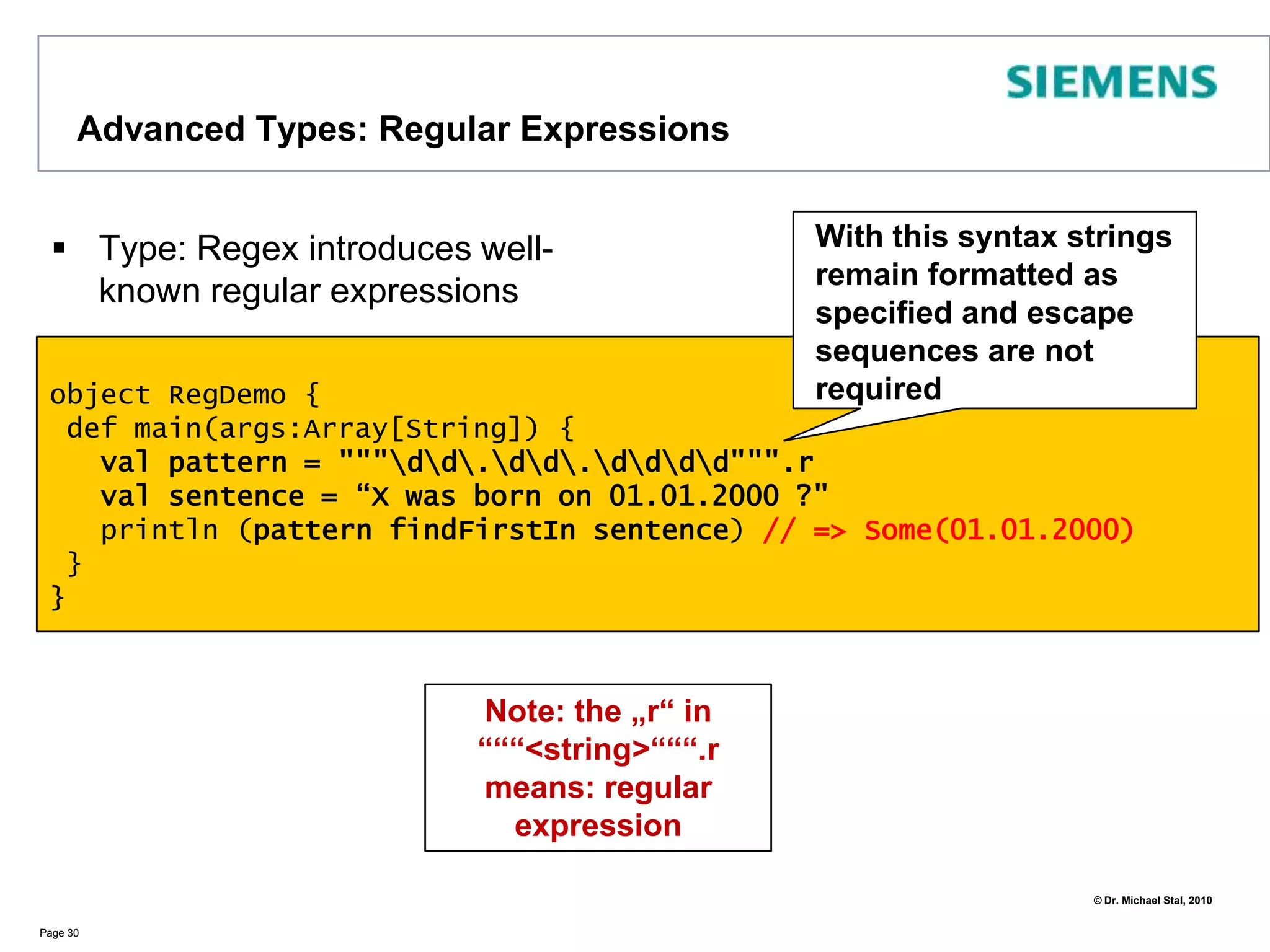
![import p1.p2.z the member z of p2, itself member of p1.Advanced Types: ListsCollection Type: ListPage 26object ListDemo { def main(args:Array[String]) { val l1 : List[Int] = Nil // empty List val l2 = List[Int](1,2,3,4,5) // list with 5 elements val l3 = 0 :: l2 // add 0 to the list val l4 = List[Int](0,1,2) ::: List[Int](3,4,5) // concat 2 lists println("Top Element: " + l4.head) // => 0 println("Rest of list: " + l4.tail) // => List(1,2,3,4,5) println("Last Element: " + l4.last) // => 5l4.foreach { i => println(i) } // => 1 <\n> 2 <\n> 3 ... }}Foreach traverses a list and passes each element found to the closure passed as argument](https://image.slidesharecdn.com/oop2010scalapresentationstal-100409090954-phpapp02/75/Oop2010-Scala-Presentation-Stal-31-2048.jpg)
![Advanced Types: SetsCollection Type: SetPage 27object SetDemo { def main(args:Array[String]) {val s1 = Set[Int](1,2,3,4,5) // we could also use = Set(1,2,3,4,5)val s2 = Set[Int](2,3,5,7)println(s2.contains(3)) // => trueval s3 = s1 ++ s2 // unionprintln(s3) // => Set(5,7,3,1,4,2)vals4 = s1 & s2 // intersection: in earlier versions **println(s4) // Set(5,3,2) }}](https://image.slidesharecdn.com/oop2010scalapresentationstal-100409090954-phpapp02/75/Oop2010-Scala-Presentation-Stal-32-2048.jpg)
![Advanced Types: MapsCollection Type: MapPage 28object MapDemo { def main(args:Array[String]) {val m1 = Map[Int, String](1 -> "Scala", 2->"Java", 3->"Clojure")valm2 = m1 + (4 -> "C#") // add entryprintln(m2 + " has size " + m2.size) //=> Map(1->Scala,…) has size 4println(m1(1)) // => Scalaval m3 = m2 filter { element => val (key, value) = element (value contains "a") } println(m3) // => Map(1->Scala, w->Java) }}](https://image.slidesharecdn.com/oop2010scalapresentationstal-100409090954-phpapp02/75/Oop2010-Scala-Presentation-Stal-33-2048.jpg)
![Advanced Types: Optionsobject DayOfWeek extends Enumeration { val Monday = Value("Monday") //argument optional val Sunday = Value("Sunday") //argument optional }import DayOfWeek._ object OptionDemo { def whatIDo(day: DayOfWeek.Value) : Option[String] = { day match { case Monday => Some("Working hard") case Sunday => None } } def main(args:Array[String]) { println(whatIDo(DayOfWeek.Monday)) println(whatIDo(DayOfWeek.Sunday)) } //=> Some(„Working Hard“) <\n> None}The Option type helps dealing with optional valuesFor instance, a search operation might return a result or nothingWe are also introducing EnumerationtypesPage 29](https://image.slidesharecdn.com/oop2010scalapresentationstal-100409090954-phpapp02/75/Oop2010-Scala-Presentation-Stal-34-2048.jpg)
![Advanced Types: Regular ExpressionsType: Regex introduces well-known regular expressionsPage 30With this syntax strings remain formatted as specified and escape sequences are not requiredobject RegDemo { def main(args:Array[String]) {val pattern = """\d\d\.\d\d\.\d\d\d\d""".rval sentence = “X was born on 01.01.2000 ?"println (pattern findFirstIn sentence) // => Some(01.01.2000) }}Note: the „r“ in “““<string>“““.r means: regular expression](https://image.slidesharecdn.com/oop2010scalapresentationstal-100409090954-phpapp02/75/Oop2010-Scala-Presentation-Stal-35-2048.jpg)
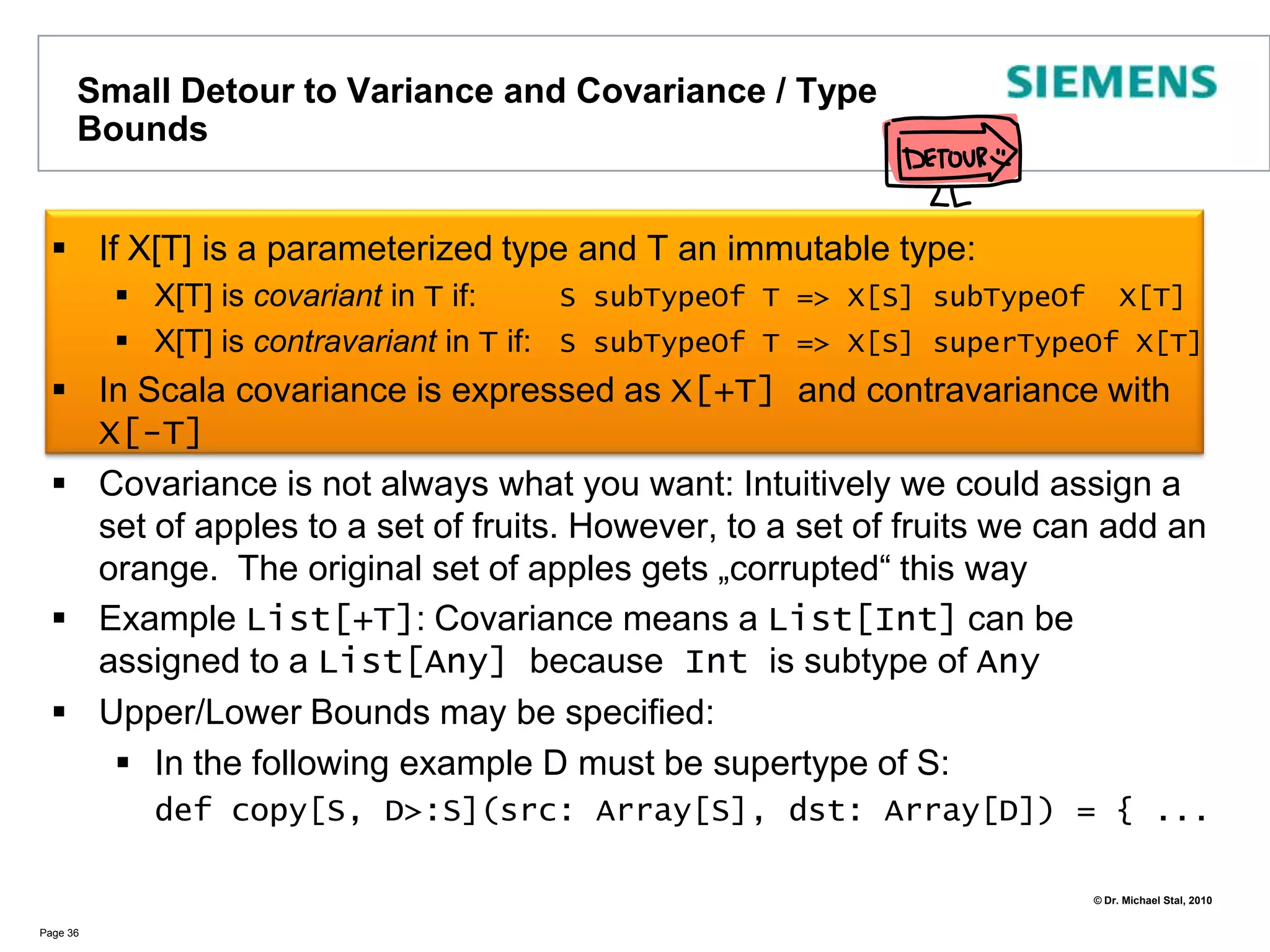
 // initialized with zeros val a2 = Array(1,2,3,4,5) // initialized with 1,2,3,4,5println( a2(1) ) // => 2a2(1) = 1 // => Array (1,1,3,4,5)Note:In Scala the assignment operator = does not return a reference to the left variable (e.g., in a = b).Thus, the following is allowed in Java but not in Scala: a = b = c](https://image.slidesharecdn.com/oop2010scalapresentationstal-100409090954-phpapp02/75/Oop2010-Scala-Presentation-Stal-37-2048.jpg)
![Smooth OperatorIn Scala operator symbols are just plain method names For instance 1 + 2 stands for 1.+(2)Precedence rules:All letters|^&< >= !:+ -* / %Page 33class Complex(val re:Double, val im:Double) {def +(that: Complex) : Complex = { new Complex(this.re + that.re, this.im + that.im) } override def toString() : String = { re + (if (im < 0) "" else "+") + im +"i" }}object Operators { def main(args: Array[String]) { val c1 = new Complex(1.0, 1.0) val c2 = new Complex(2.0, 1.0) println(c1+c2) }} // => (3.0+2.0i)](https://image.slidesharecdn.com/oop2010scalapresentationstal-100409090954-phpapp02/75/Oop2010-Scala-Presentation-Stal-38-2048.jpg)
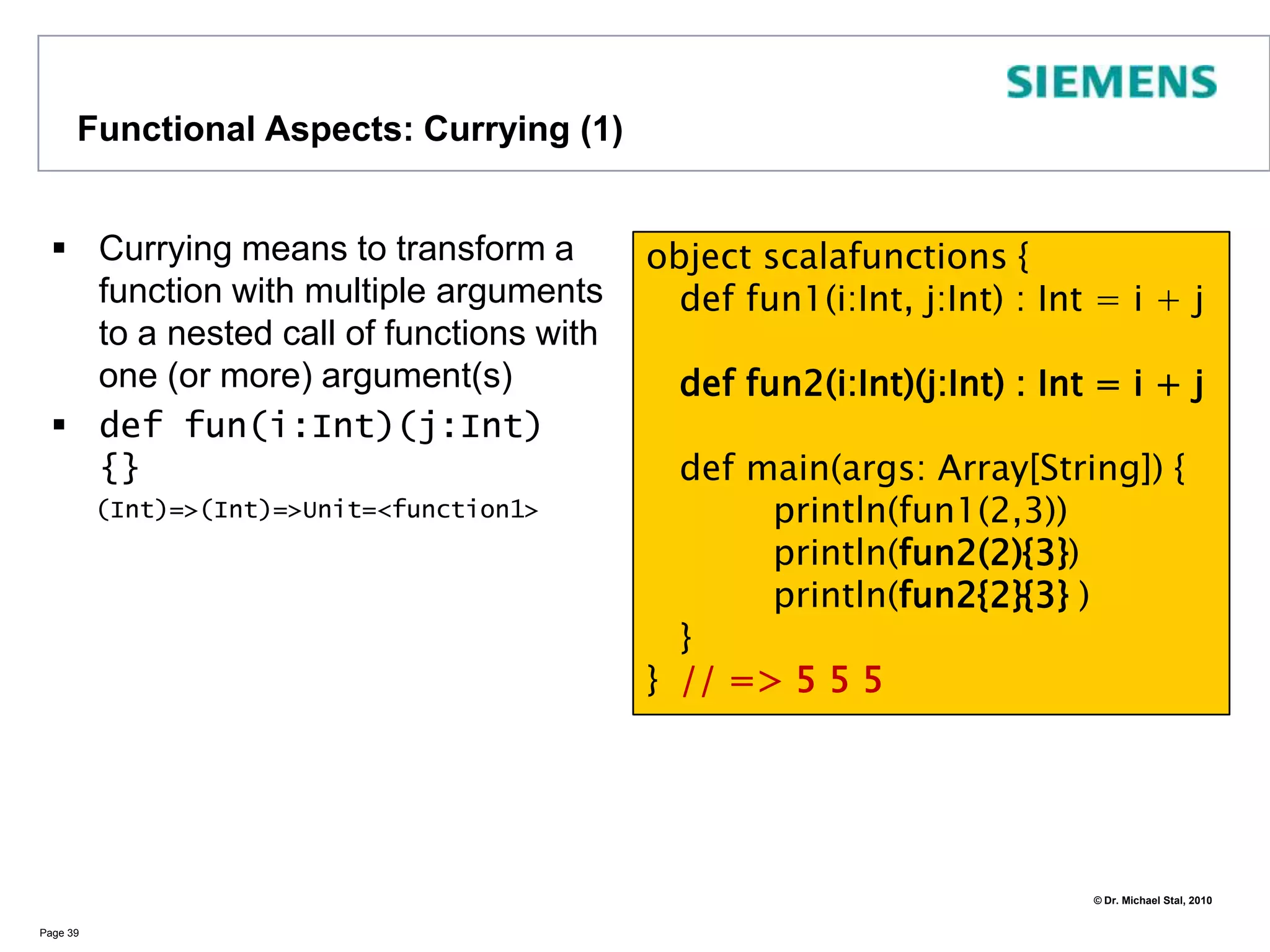
![Parameterized Types in ScalaClasses, Traits, Functions may be parameterized with typesIn contrast to Java no wildcards permitted – parameter types must have namesVariance specification allow to specify covariance and contravariancePage 35trait MyTrait[S,T] { def print(s:S, t:T) : String = "(" + s + "," + t + ")"}class MyPair[S,T] (val s : S, val t : T) extends MyTrait [S,T] { override def toString() : String = print(s,t) }object Generics { def main(args: Array[String]) { val m = new MyPair[Int,Int](1,1) printf(m.toString()) }} // => (1,1)](https://image.slidesharecdn.com/oop2010scalapresentationstal-100409090954-phpapp02/75/Oop2010-Scala-Presentation-Stal-40-2048.jpg)
![Small Detour to Variance and Covariance / Type BoundsIf X[T] is a parameterized type and T an immutable type:X[T] is covariant in T if: S subTypeOf T => X[S] subTypeOf X[T]X[T] is contravariant in T if: S subTypeOf T => X[S] superTypeOf X[T]In Scala covariance is expressed as X[+T] and contravariance with X[-T]Covariance is not always what you want: Intuitively we could assign a set of apples to a set of fruits. However, to a set of fruits we can add an orange. The original set of apples gets „corrupted“ this wayExample List[+T]: Covariance means a List[Int] can be assigned to a List[Any] because Int is subtype of AnyUpper/Lower Bounds may be specified:In the following example D must be supertype of S: def copy[S, D>:S](src: Array[S], dst: Array[D]) = { ...Page 36](https://image.slidesharecdn.com/oop2010scalapresentationstal-100409090954-phpapp02/75/Oop2010-Scala-Presentation-Stal-41-2048.jpg)
![Functional Aspects: Functions and ClosuresIn Scala Functions are First-Class CitizensThey can be passed as argumentsassigned to variables: val closure={i:Int => i+42}Nested functions are also supportedPage 37object scalafunctions { def add(left:Int,right:Int, code:Int=>Int)= {var res = 0 for (i<-left to right) res += code(i) res } def main(args: Array[String]) {println(add(0,10, i => i))println(add(10,20, i => i % 2 )) }}=>555](https://image.slidesharecdn.com/oop2010scalapresentationstal-100409090954-phpapp02/75/Oop2010-Scala-Presentation-Stal-42-2048.jpg)
![Functional Aspects: Call-by-NameIf a parameterless closure is passed as an argument to a function, Scala will evaluate the argument when the argument is actually usedThis is in contrast to call-by-value argumentsA similar effect can be achieved using lazy (value) evaluation: lazy val = <expr> Page 38import java.util._object CbNDemo {def fun(v: => Int) : Int = v // v is a Call-by-Name Parameterdef v() : Int = new Random().nextInt(1000) def main(args:Array[String]) { println( fun(v) ) println( fun(v) ) }} // => 123 <\n> 243](https://image.slidesharecdn.com/oop2010scalapresentationstal-100409090954-phpapp02/75/Oop2010-Scala-Presentation-Stal-43-2048.jpg)
![Functional Aspects: Currying (1)Currying means to transform a function with multiple arguments to a nested call of functions with one (or more) argument(s)def fun(i:Int)(j:Int) {} (Int)=>(Int)=>Unit=<function1>Page 39object scalafunctions { def fun1(i:Int, j:Int) : Int = i + jdef fun2(i:Int)(j:Int) : Int = i + j def main(args: Array[String]) { println(fun1(2,3)) println(fun2(2){3}) println(fun2{2}{3} ) }} // => 5 5 5](https://image.slidesharecdn.com/oop2010scalapresentationstal-100409090954-phpapp02/75/Oop2010-Scala-Presentation-Stal-44-2048.jpg)
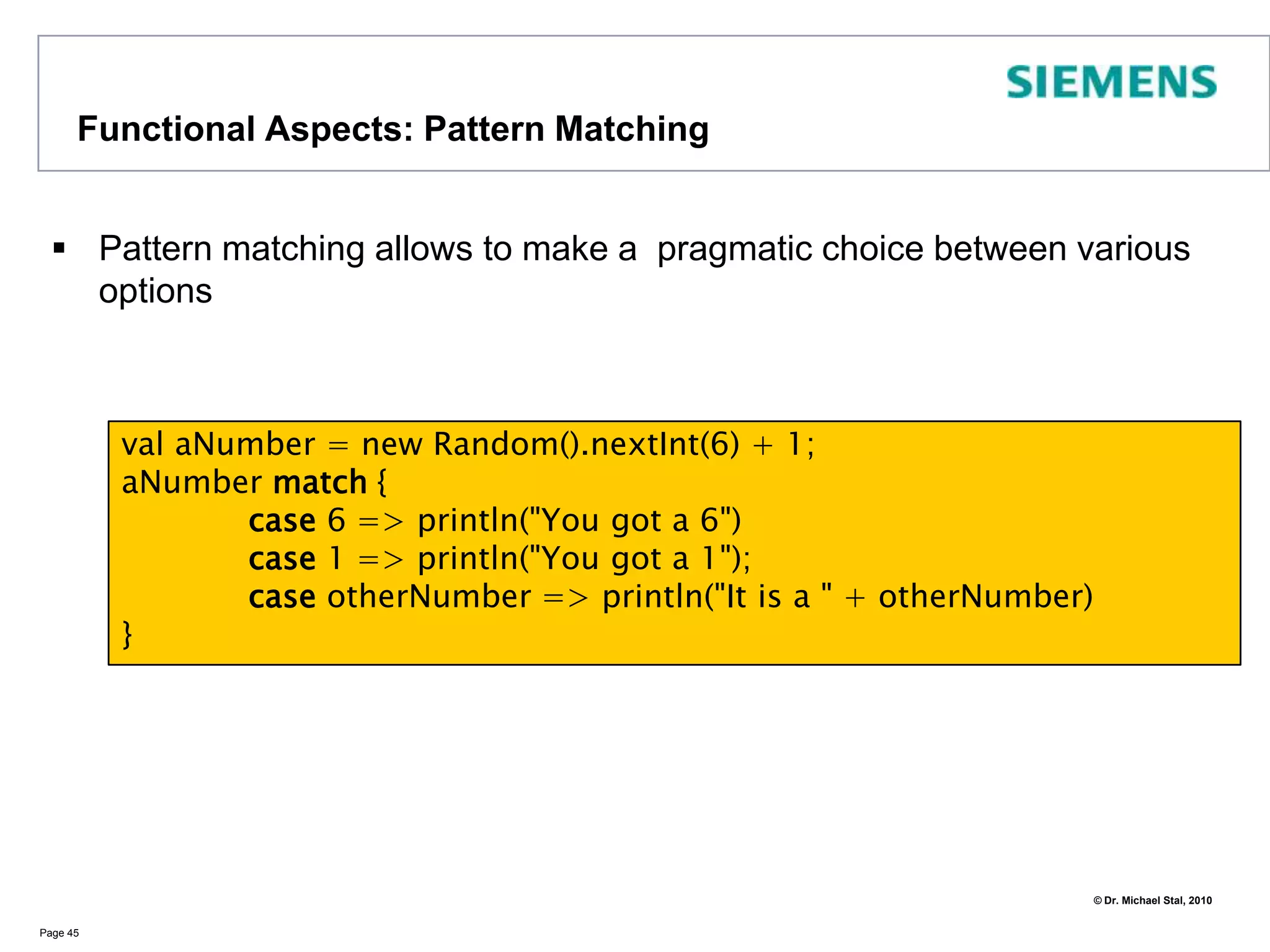
![Positional ParametersIf you use a parameter only once, you can use positional notation of parameters with _ (underscore) insteadPage 41object scalafunctions { def main(args:Array[String]) { val seq= (1 to 10) println( (0 /: seq) { (sum, elem) => sum + elem } ) println( (0 /: seq) { _ + _ } ) } }](https://image.slidesharecdn.com/oop2010scalapresentationstal-100409090954-phpapp02/75/Oop2010-Scala-Presentation-Stal-46-2048.jpg)
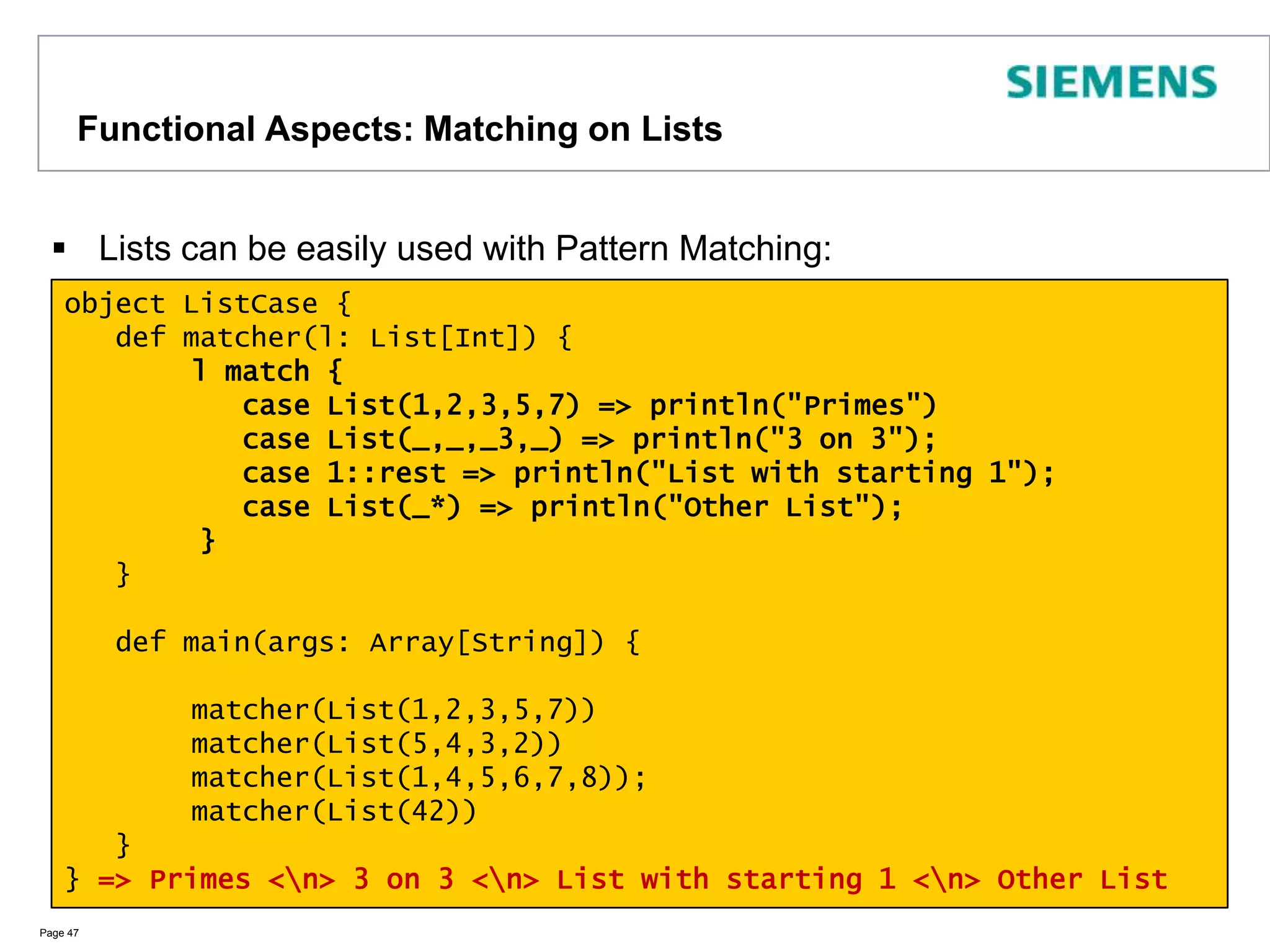
![Functional Aspect: Partially Applied FunctionsIf you only provide a subset of arguments to a function call, you actually retrieve a partially defined functionOnly the passed arguments are bound, all others are notIn a call to a partially applied function you need to pass the unbound argumentsAll this is useful to leverage the DRY principle when passing the same arguments again and againPage 43object scalafunctions { def fun(a : Int, b : Int, c:Int) = a+b+c def main(args: Array[String]) {val partialFun = fun(1,2,_:Int) println( partialFun(3) ) // 6 println( partialFun(4) ) // 7 }}](https://image.slidesharecdn.com/oop2010scalapresentationstal-100409090954-phpapp02/75/Oop2010-Scala-Presentation-Stal-48-2048.jpg)
![Functions Are Objects Function: S => T trait Function1[-S,+T] { def apply(x:S):T }Example: (x: Int) => x * 2-> new Function1[Int,Int] { def apply(X:Int):Int = x * 2 }In Scala all function values are objectsBasically, each function is identical to a class with an apply methodThus, you can even derive subclasses from functionsArray is an example for this: class Array [T] (length: Int ) extends (Int => T) {def length: Int = ...Page 44](https://image.slidesharecdn.com/oop2010scalapresentationstal-100409090954-phpapp02/75/Oop2010-Scala-Presentation-Stal-49-2048.jpg)
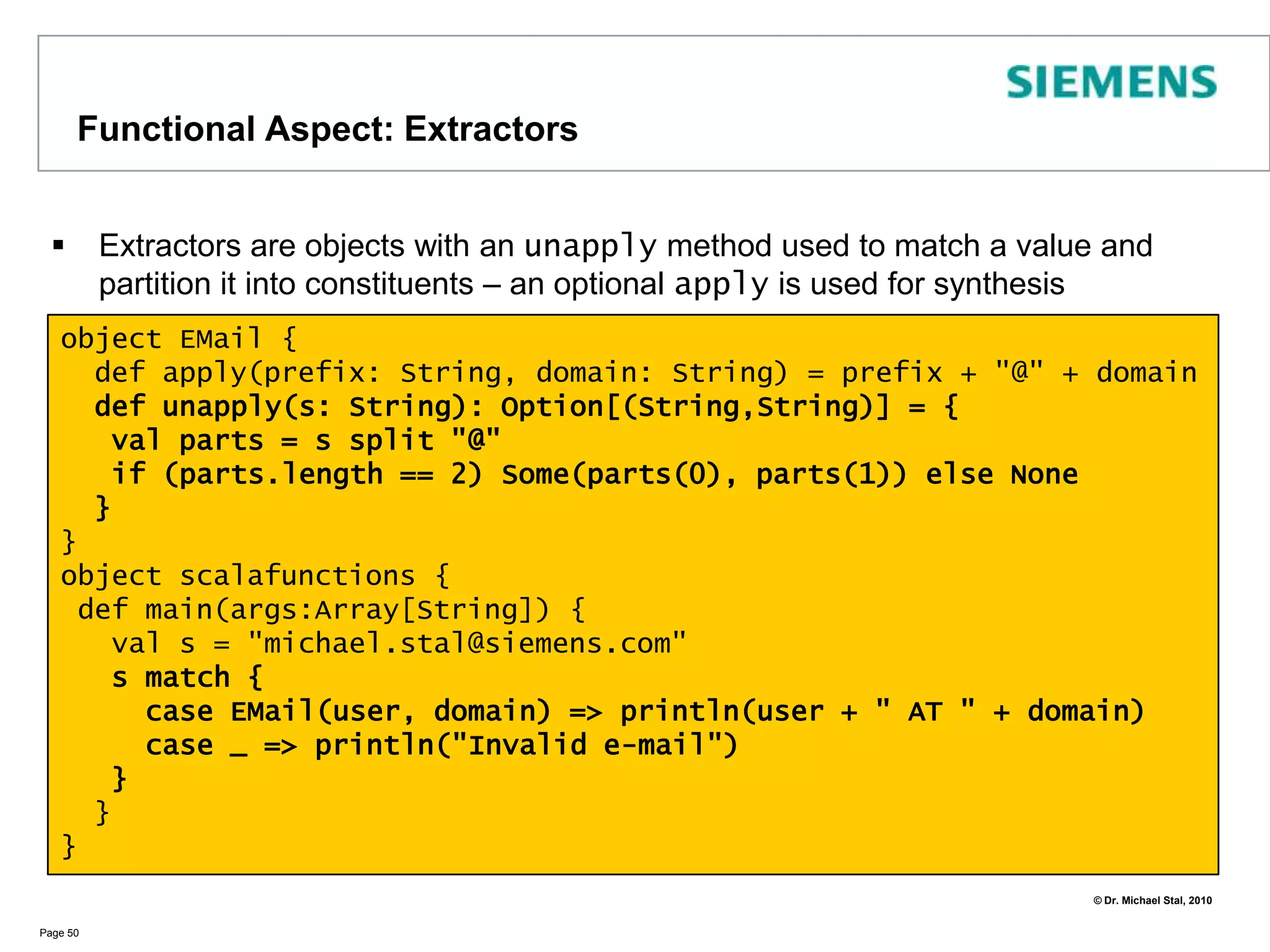
![Functional Aspects: Matching on TypesIt is also possible to differentiate by type:Page 46object TypeCase { def matcher(a: Any) {a match { case i : Int if (i == 42) => println("42") case j : Int => println("Another int") case s : String => println(s) case _ => println("Something else") } } def main(args: Array[String]) { matcher(42) matcher(1) matcher("OOP") matcher(1.3) }} // => 41 <\n> 1 <\n> OOP <\n> Something else](https://image.slidesharecdn.com/oop2010scalapresentationstal-100409090954-phpapp02/75/Oop2010-Scala-Presentation-Stal-51-2048.jpg)
![Functional Aspects: Matching on ListsLists can be easily used with Pattern Matching:Page 47object ListCase { def matcher(l: List[Int]) {l match { case List(1,2,3,5,7) => println("Primes") case List(_,_,_3,_) => println("3 on 3"); case 1::rest => println("List with starting 1"); case List(_*) => println("Other List"); } } def main(args: Array[String]) { matcher(List(1,2,3,5,7)) matcher(List(5,4,3,2)) matcher(List(1,4,5,6,7,8)); matcher(List(42)) }} => Primes <\n> 3 on 3 <\n> List with starting 1 <\n> Other List](https://image.slidesharecdn.com/oop2010scalapresentationstal-100409090954-phpapp02/75/Oop2010-Scala-Presentation-Stal-52-2048.jpg)
![Functional Aspects: Matching on TuplesSo do Tuples:Page 48object TupleCase { def matcher(t : Tuple2[String,String]) {t match { case ("OOP",s) => println("OOP " + s) case ("Scala", s) => println("Scala " + s) case _ => println("Other Tuple") } } def main(args: Array[String]) { matcher("OOP", "2010") matcher("Scala", "rocks"); matcher("A","B") }} => OOP 2010 <\n> Scala rocks >cr> Other Tuple](https://image.slidesharecdn.com/oop2010scalapresentationstal-100409090954-phpapp02/75/Oop2010-Scala-Presentation-Stal-53-2048.jpg)
![Functional Aspects: Matching on Case ClassesCase Classes are classes for which the compiler generates additional functionality to enable pattern matching, e.g., an apply() method:Page 49sealed abstract class Shape // sealed => subclasses only in this source filecase class Circle(val center: Point, val radius: Double) extends Shapecase class Line(val pt1: Point, val pt2: Point) extends Shapecase class Point (val x:Double, val y:Double){ override def toString() = "(" + x +"," + y + ")" }object CaseClasses { def matcher(s : Shape) {s match { case Circle(c, r) => println(“Circle“ : + c + “ “ + r) case Line(p1, p2) => println("Line " + p1 + " : " + p2) case _ => println("Unknown shape") } } def main(args: Array[String]) { matcher(Circle(Point(1.0, 1.0), 2.0)) matcher(Line(Point(1.0, 1.0), Point(2.0, 2.0))) }}](https://image.slidesharecdn.com/oop2010scalapresentationstal-100409090954-phpapp02/75/Oop2010-Scala-Presentation-Stal-54-2048.jpg)
![Functional Aspect: ExtractorsExtractors are objects with an unapply method used to match a value and partition it into constituents – an optional apply is used for synthesisPage 50object EMail { def apply(prefix: String, domain: String) = prefix + "@" + domaindef unapply(s: String): Option[(String,String)] = { val parts = s split "@" if (parts.length == 2) Some(parts(0), parts(1)) else None } }object scalafunctions { def main(args:Array[String]) { val s = "michael.stal@siemens.com" s match { case EMail(user, domain) => println(user + " AT " + domain) case _ => println("Invalid e-mail") } } }](https://image.slidesharecdn.com/oop2010scalapresentationstal-100409090954-phpapp02/75/Oop2010-Scala-Presentation-Stal-55-2048.jpg)
![Partial Functions Partial Functions are not defined for all domain valuesCan be asked with isDefinedAt whether a domain value is acceptedExample: Blocks of Pattern Matching CasesPage 51trait PartialFunction[-D, +T] extends (D => T) { def isDefinedAt(x: D): Boolean}](https://image.slidesharecdn.com/oop2010scalapresentationstal-100409090954-phpapp02/75/Oop2010-Scala-Presentation-Stal-56-2048.jpg)
![ActorsActors have been introduced in the 1970s:the Actor model is a mathematical model of concurrent computationthat treats "actors" as the universal primitives of concurrent digital computation: in response to a message that it receives, an actor can make local decisions, create more actors, send more messages, and determine how to respond to the next message received. [Hewitt, 73]Page 52Also available in Erlang, Axum, Io, ClojureProvided as library implementation in Scala (demonstrating Scala‘s capability of providing internal DSLs)](https://image.slidesharecdn.com/oop2010scalapresentationstal-100409090954-phpapp02/75/Oop2010-Scala-Presentation-Stal-57-2048.jpg)
![Actor ClassesClass Actor requires to override act() which is the functionality executed by a threadYou may also instantiate anonymous actors in a much more convenient way:Page 53import scala.actors.Actorclass VolcanextendsActor {def act() {println(“thinking ...") }}object SpockRunner { def main(args:Array[String]) = {valspock = new Volcanspock start }}import scala.actors.Actorimport Actor._object SpockRunner { def main(args:Array[String]) = {val spock = actor { println("thinking ...") } }}](https://image.slidesharecdn.com/oop2010scalapresentationstal-100409090954-phpapp02/75/Oop2010-Scala-Presentation-Stal-58-2048.jpg)
